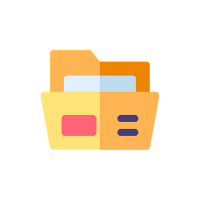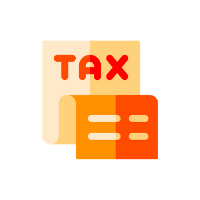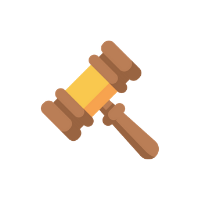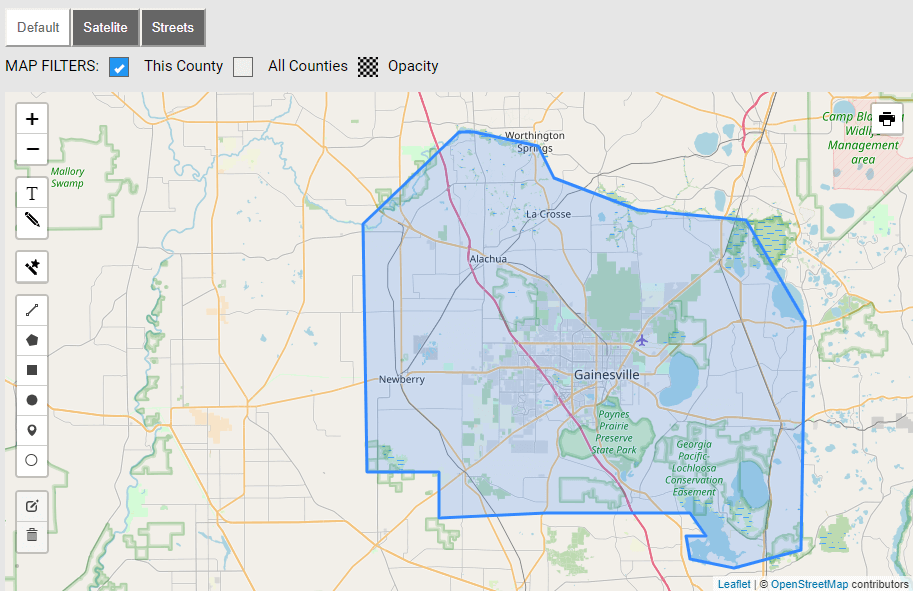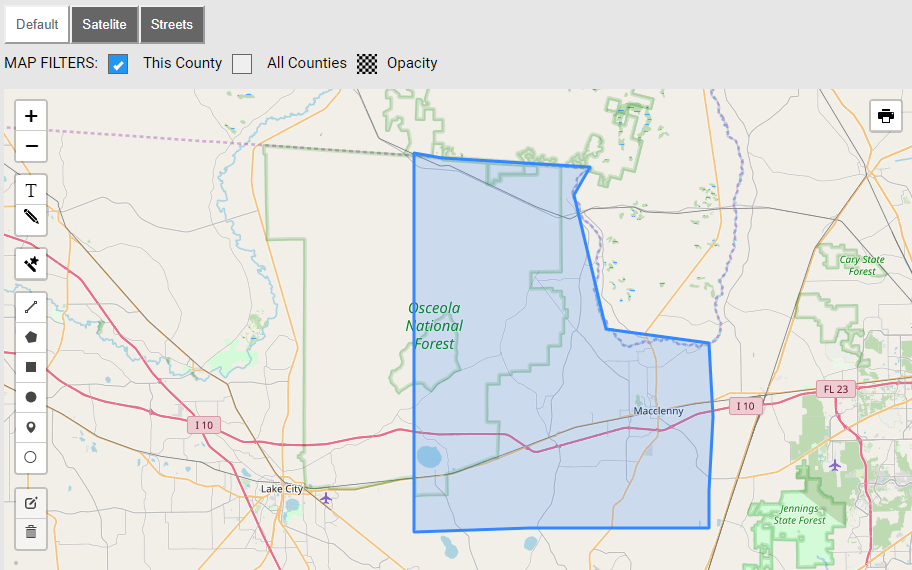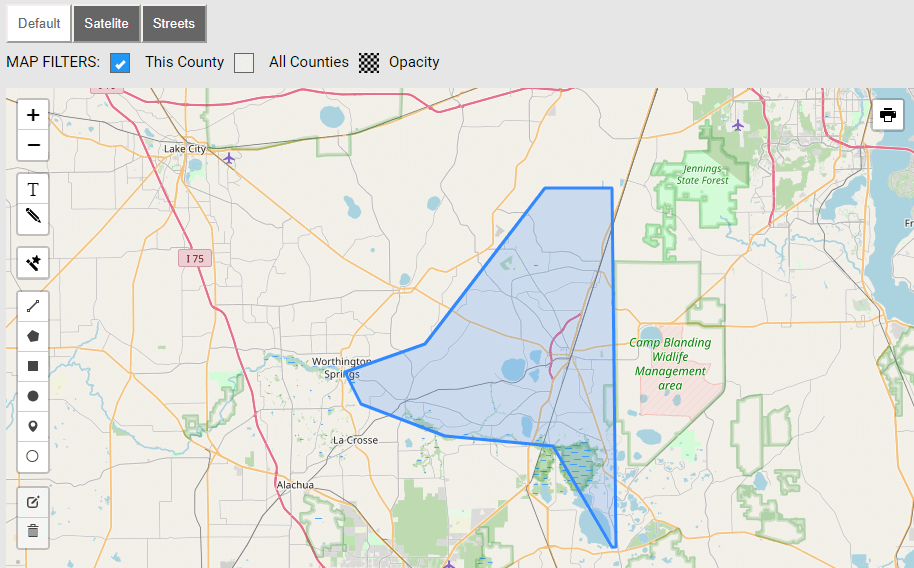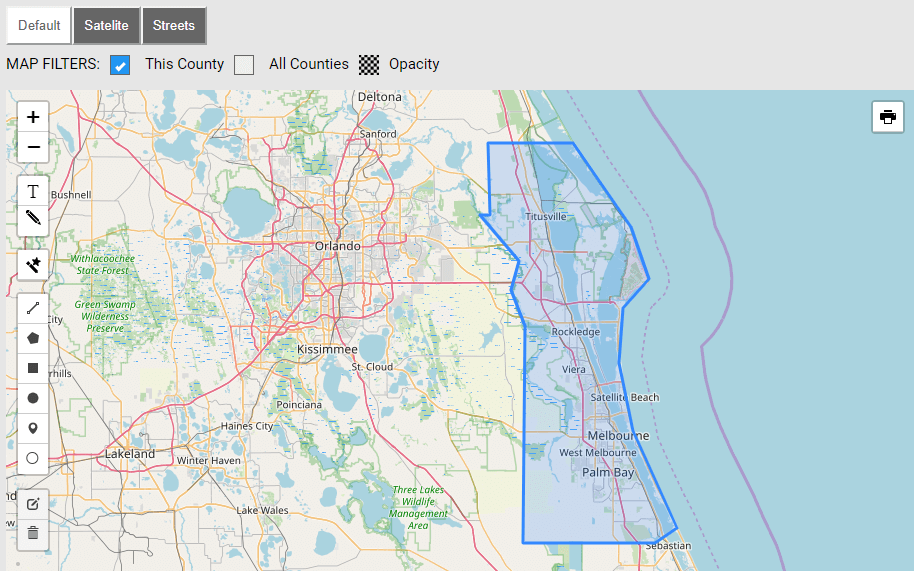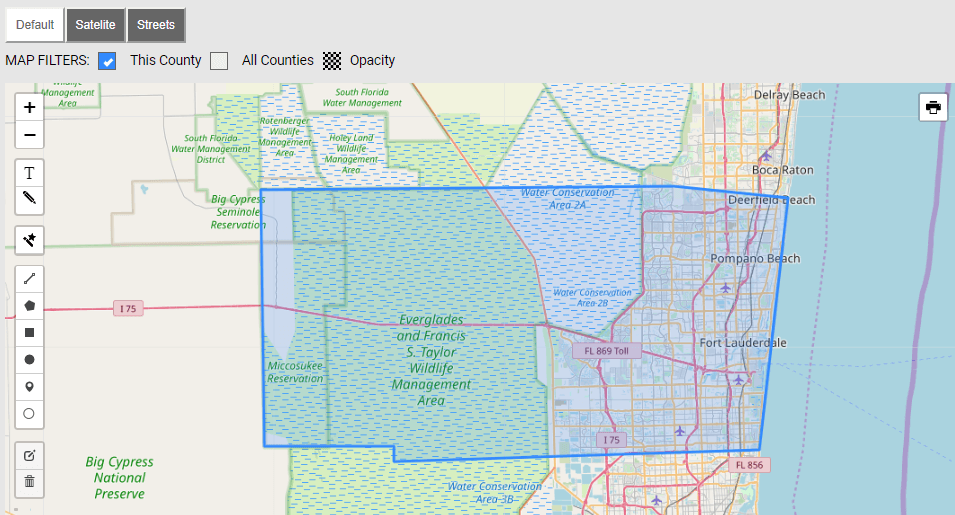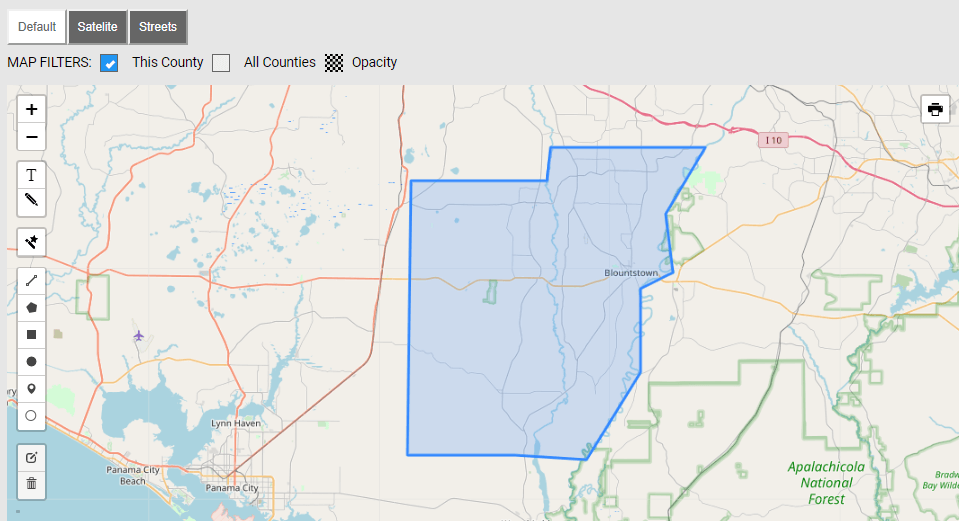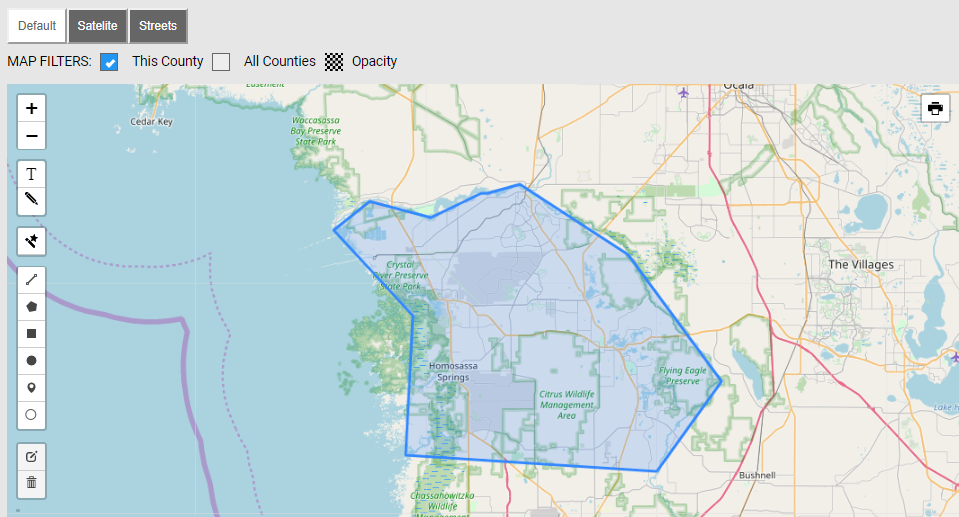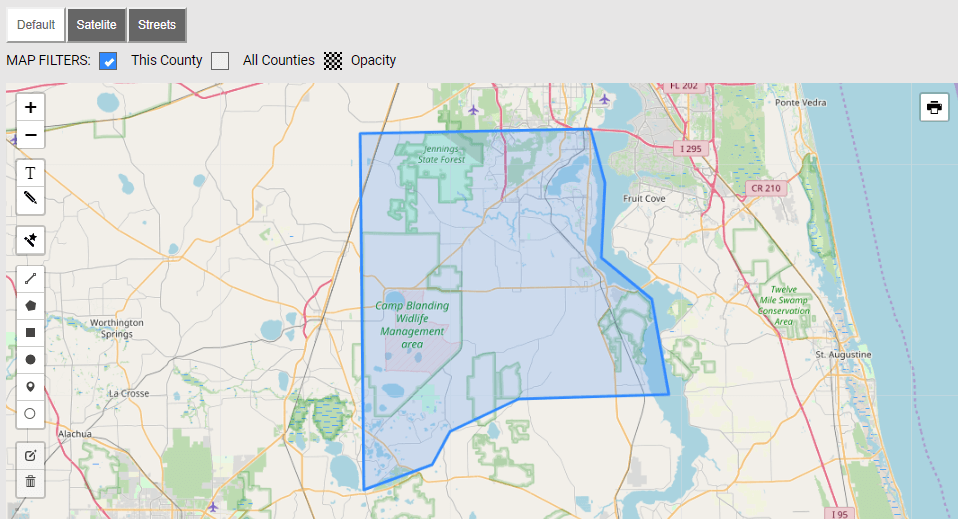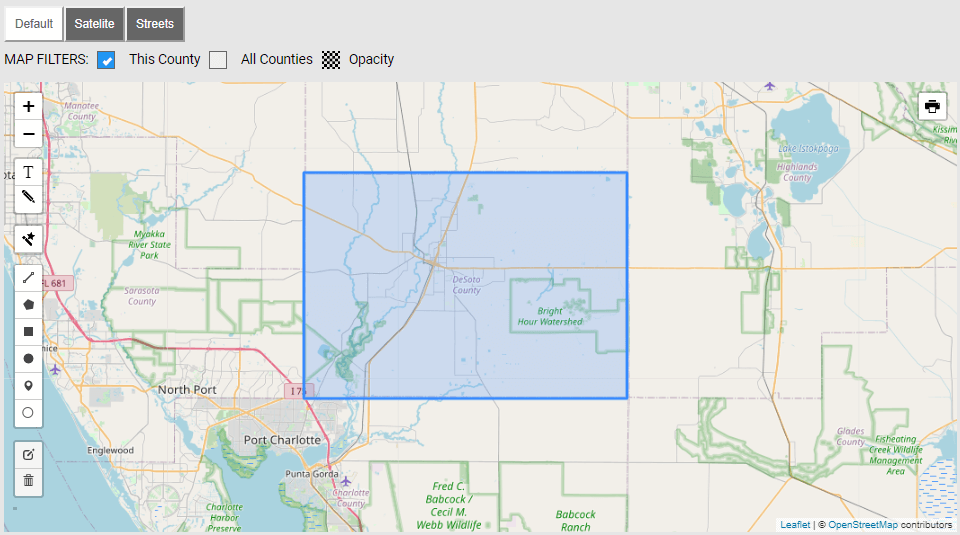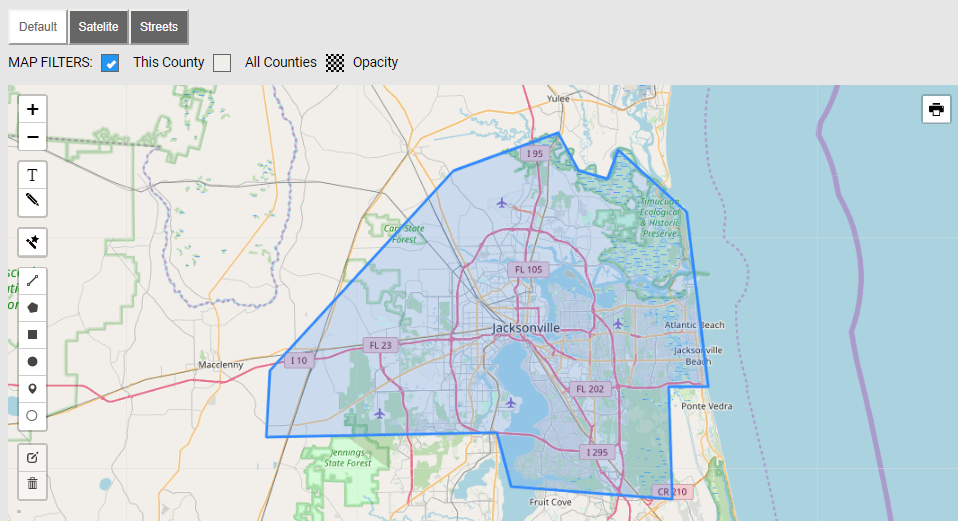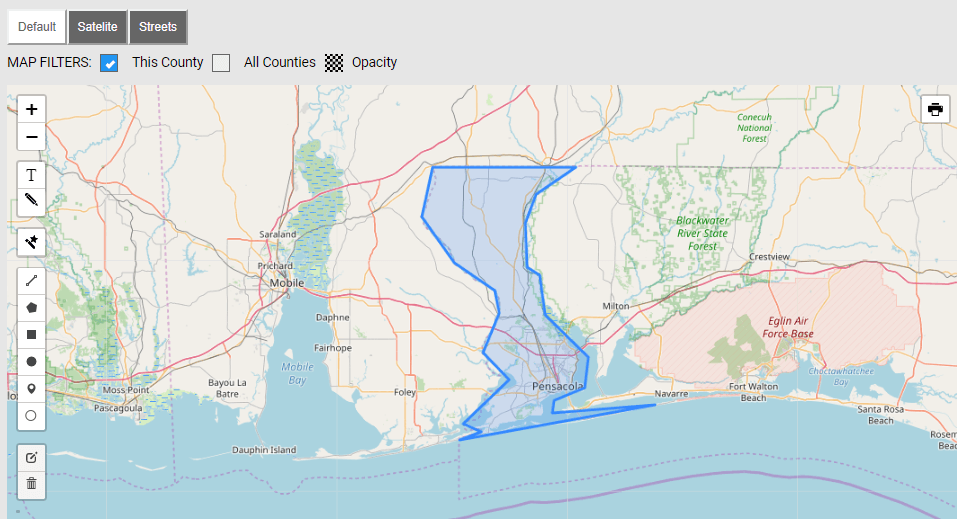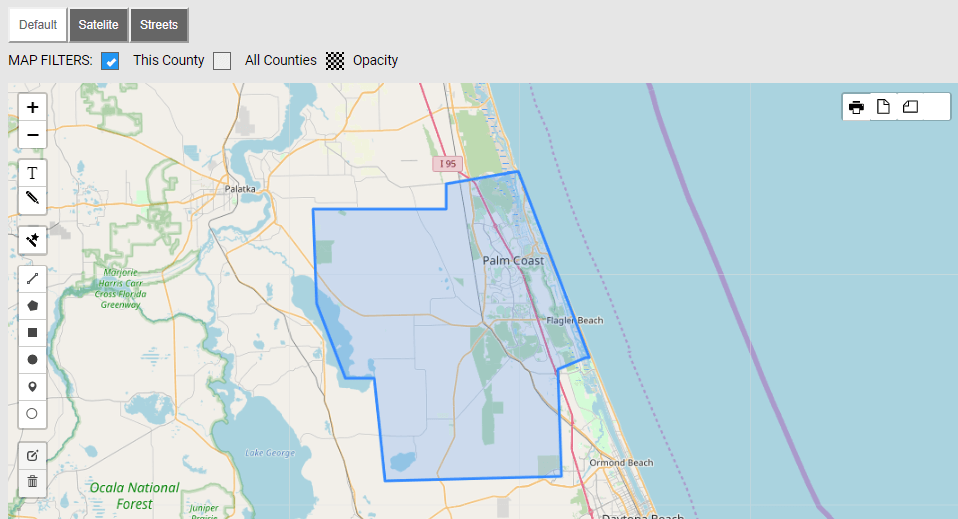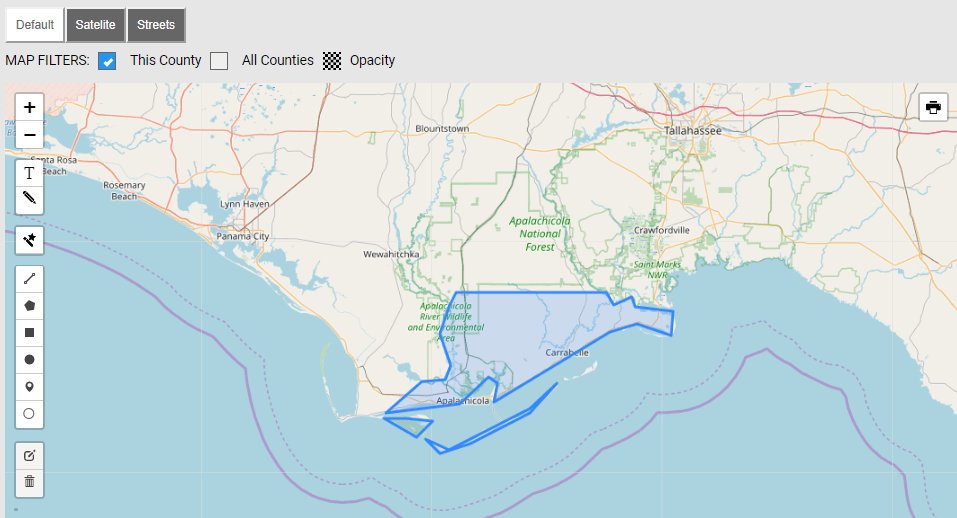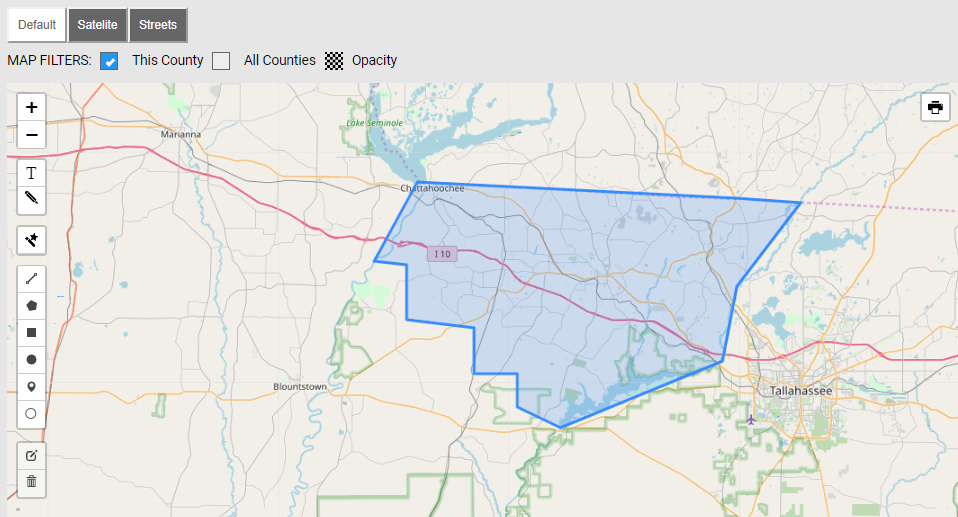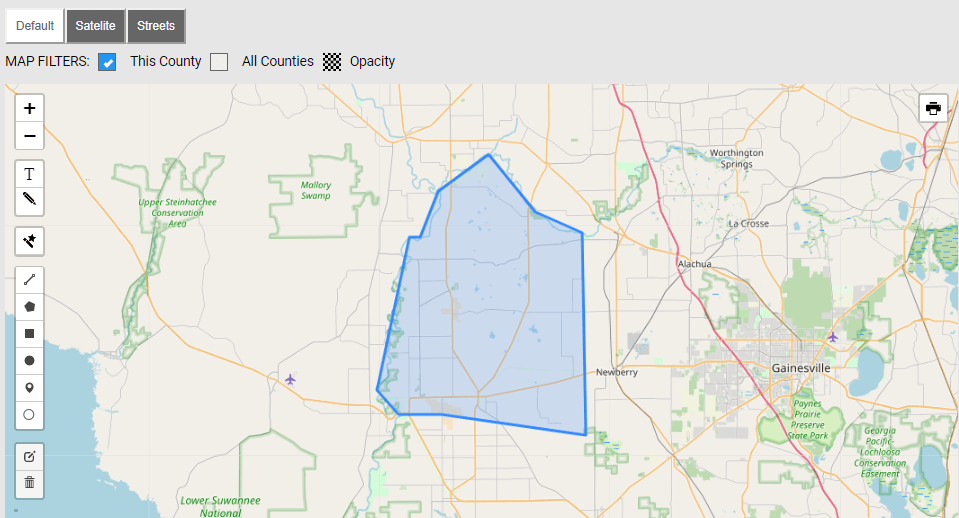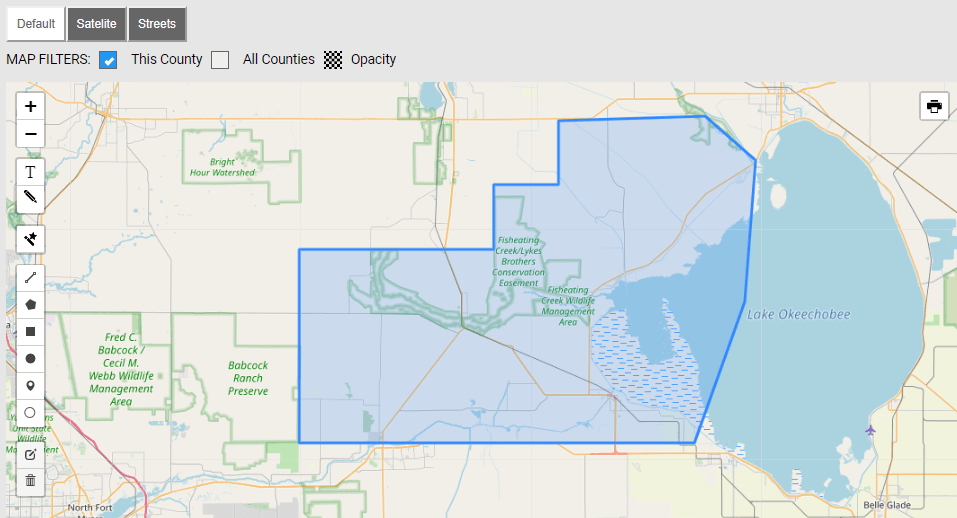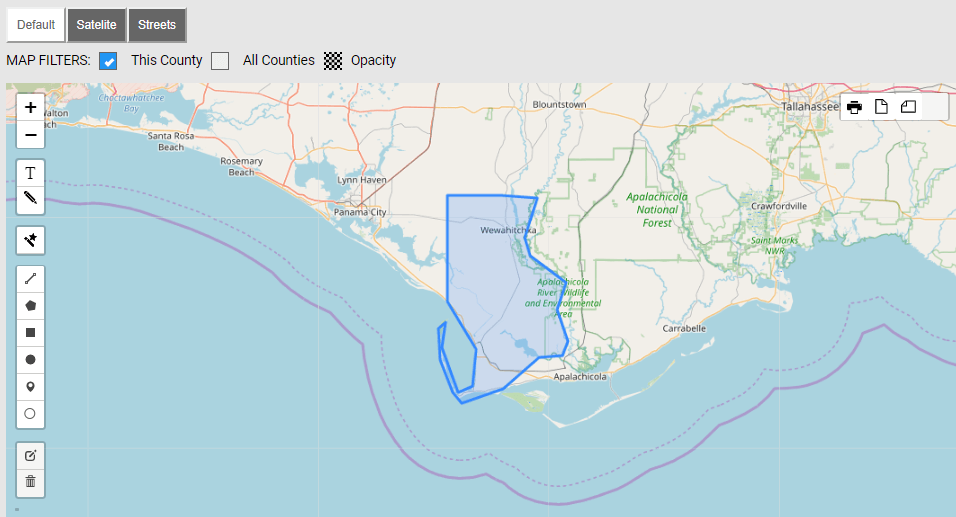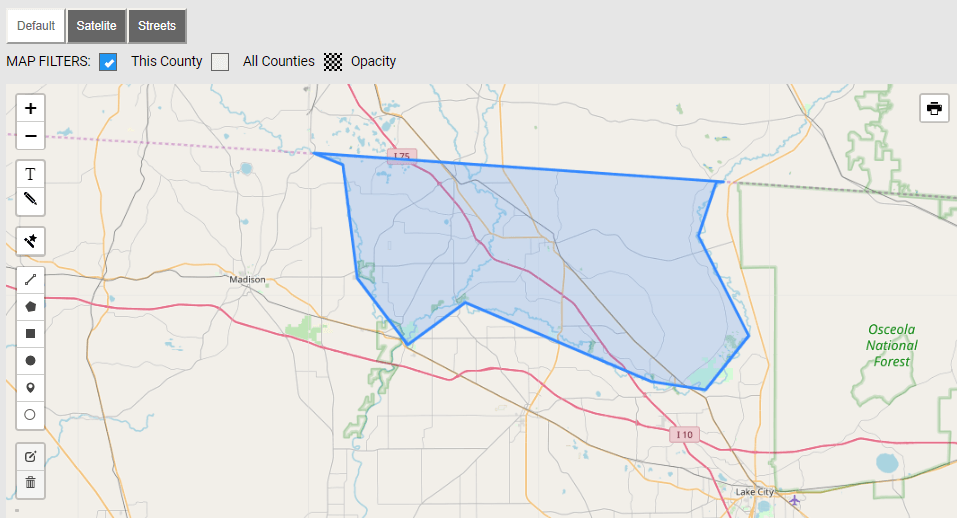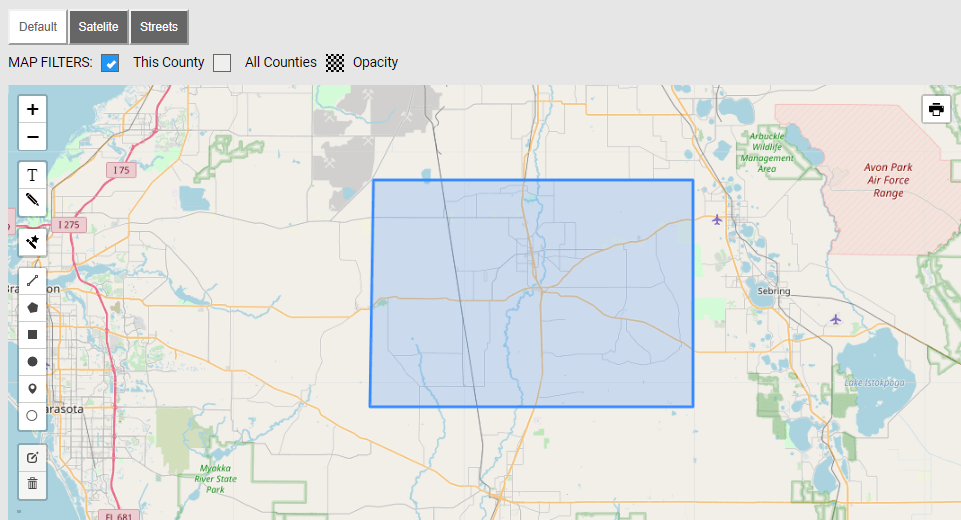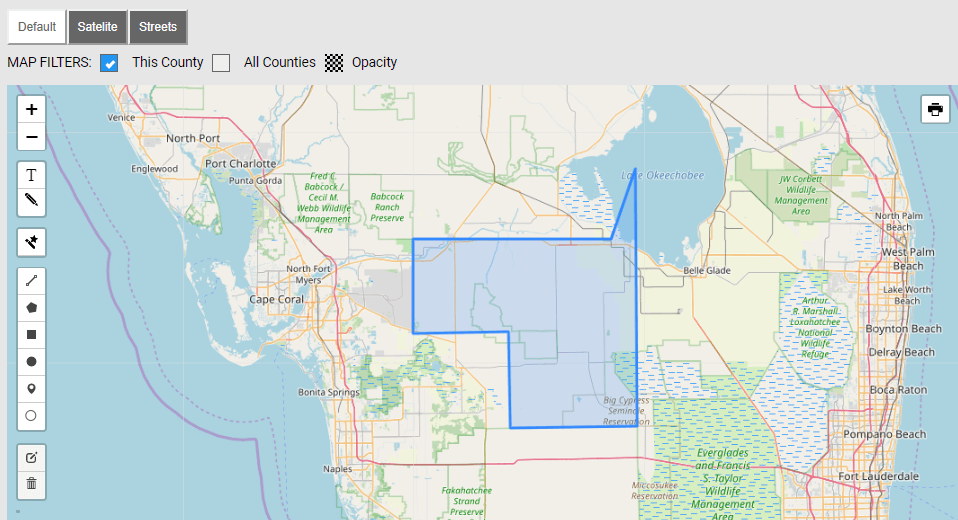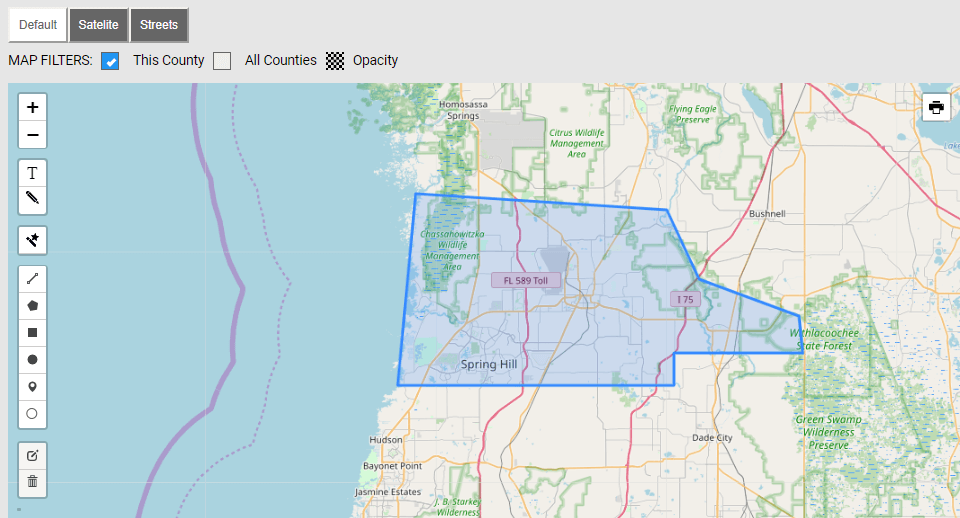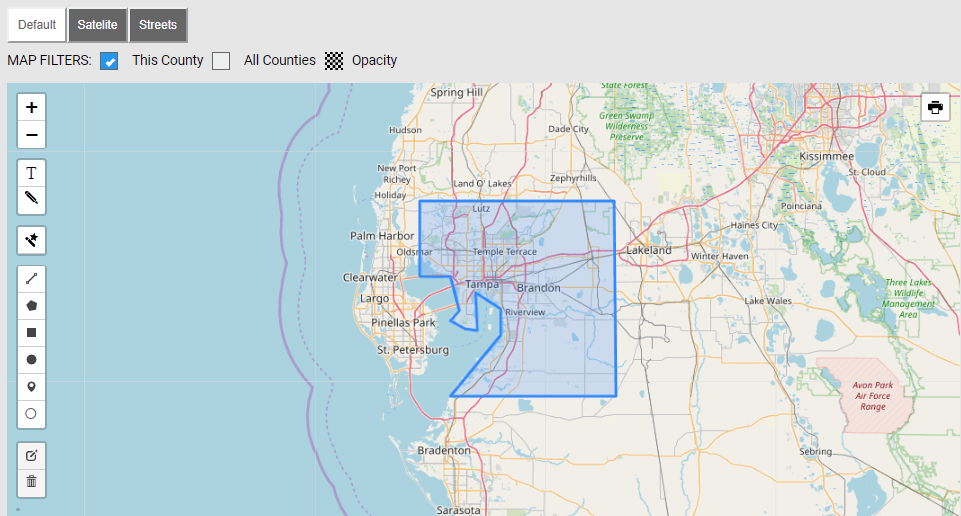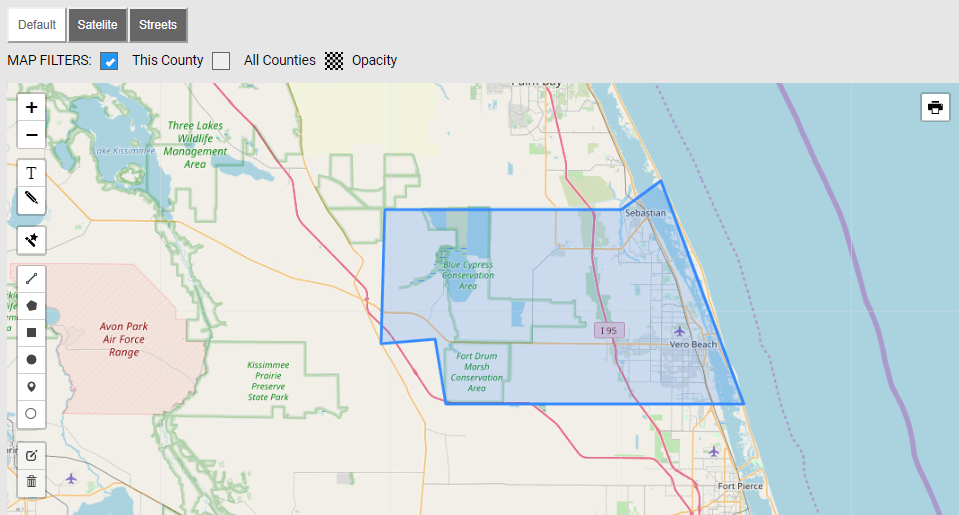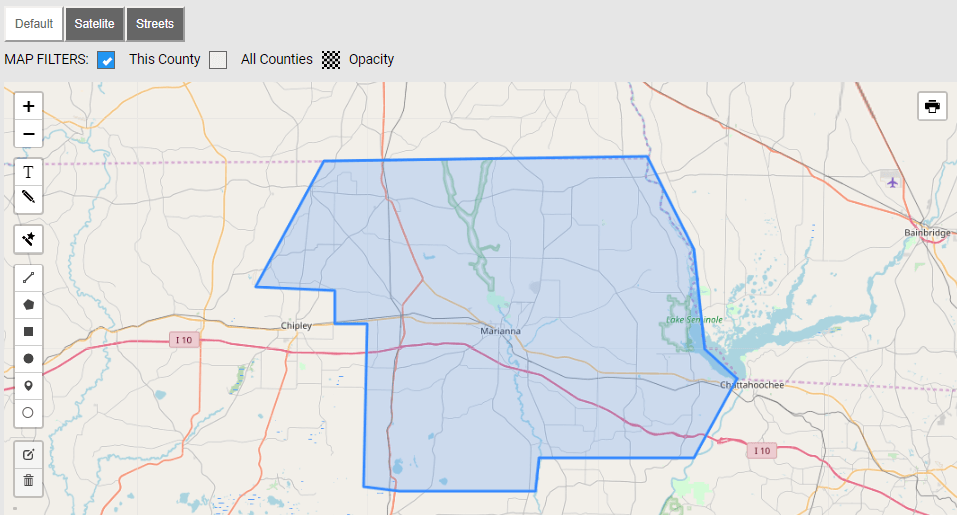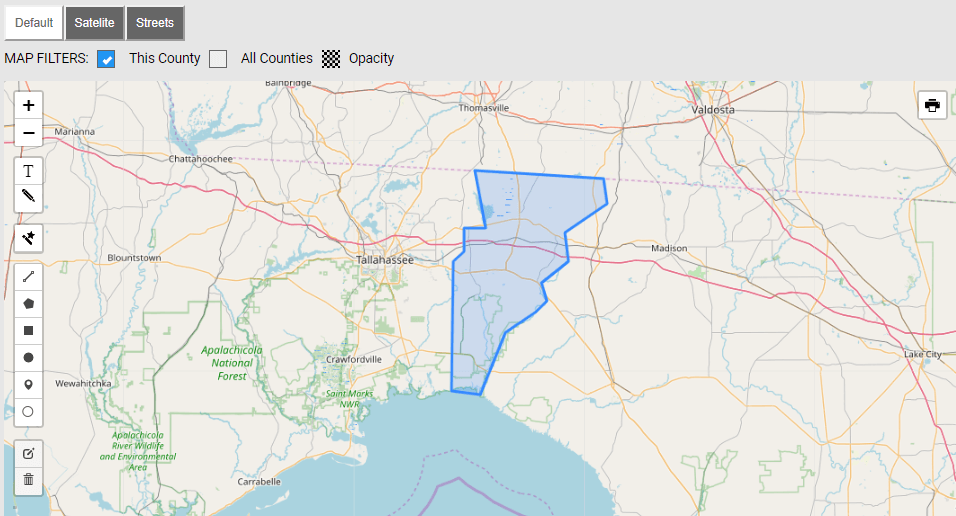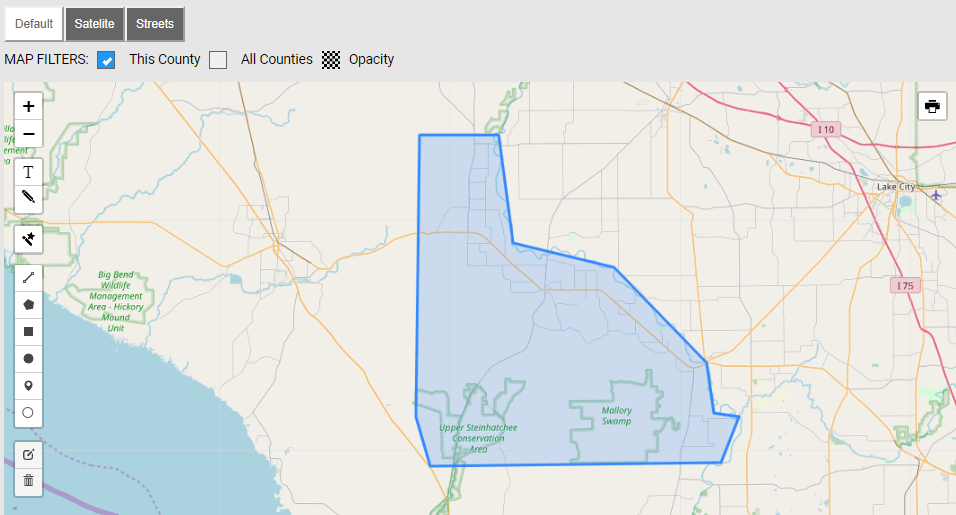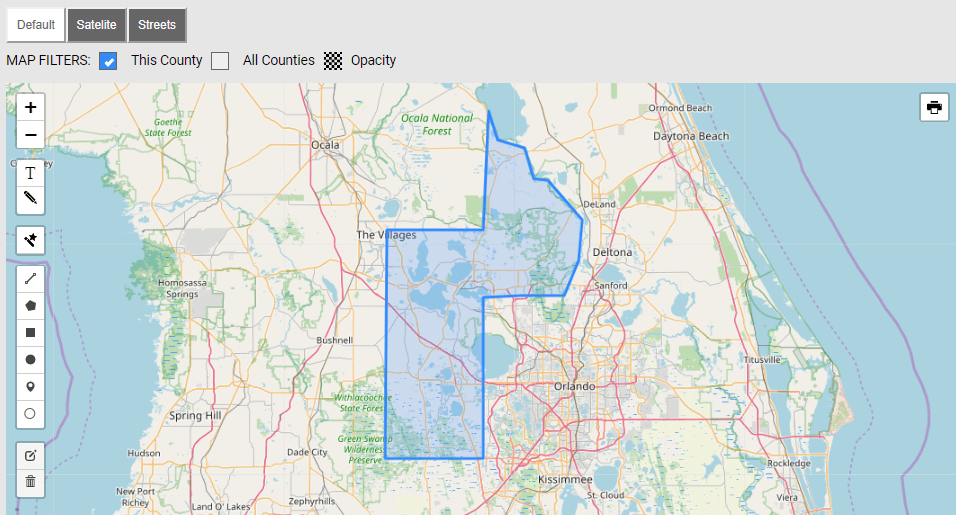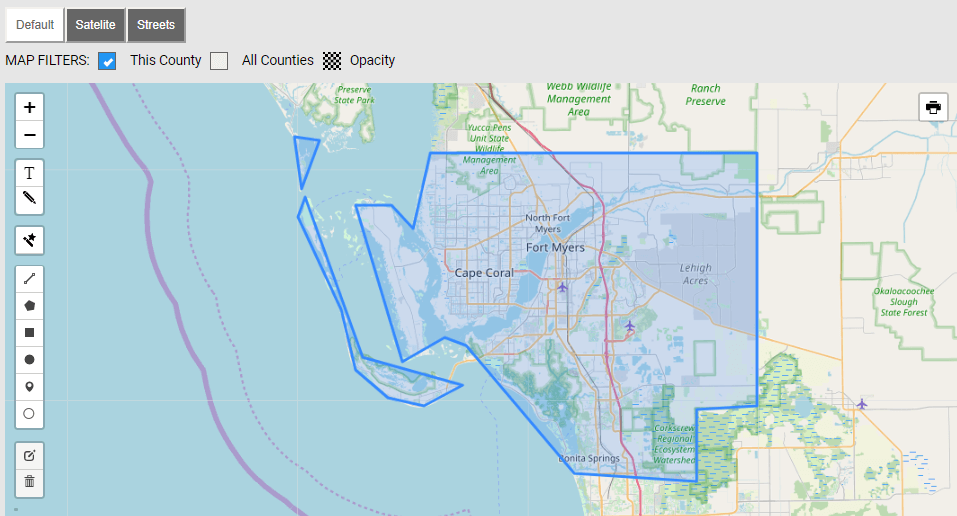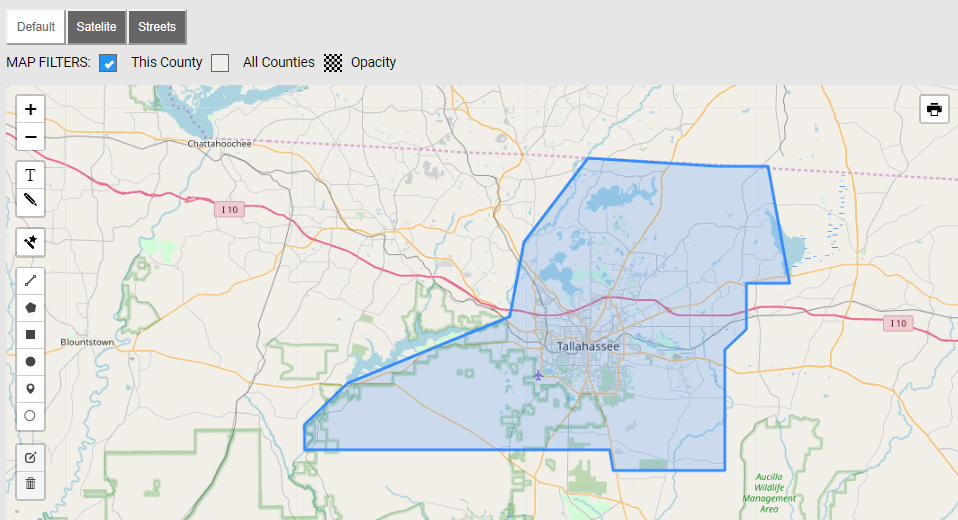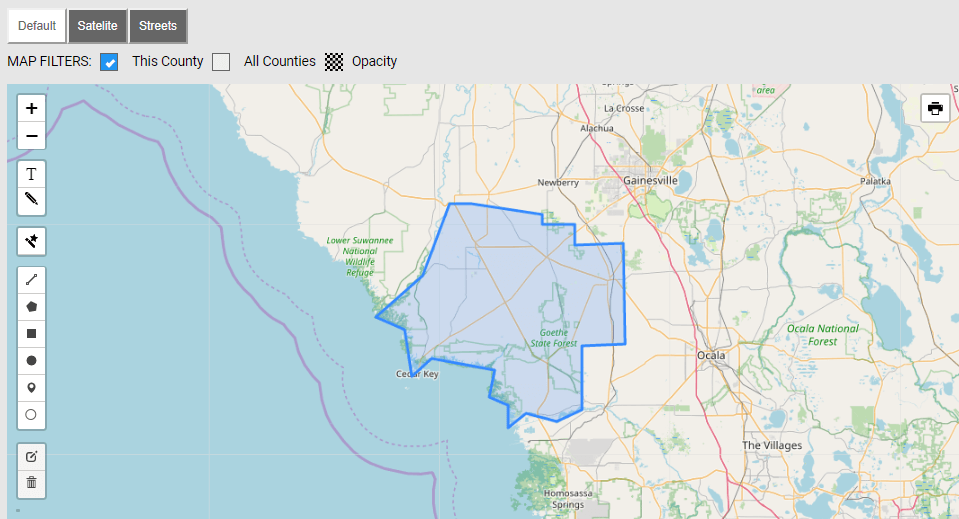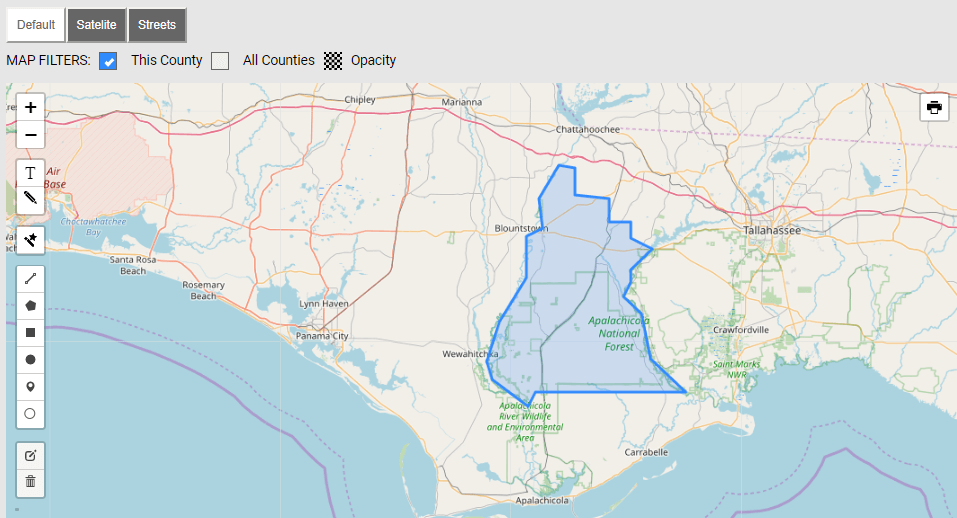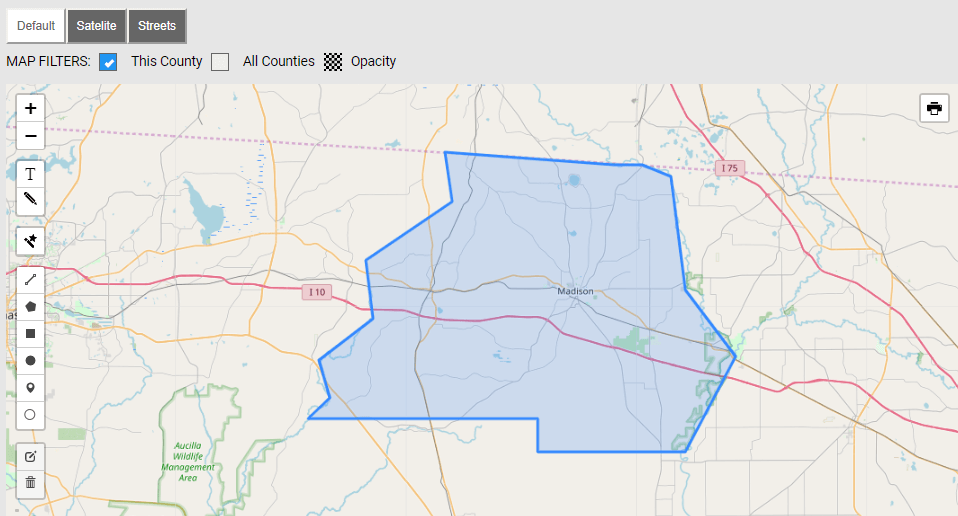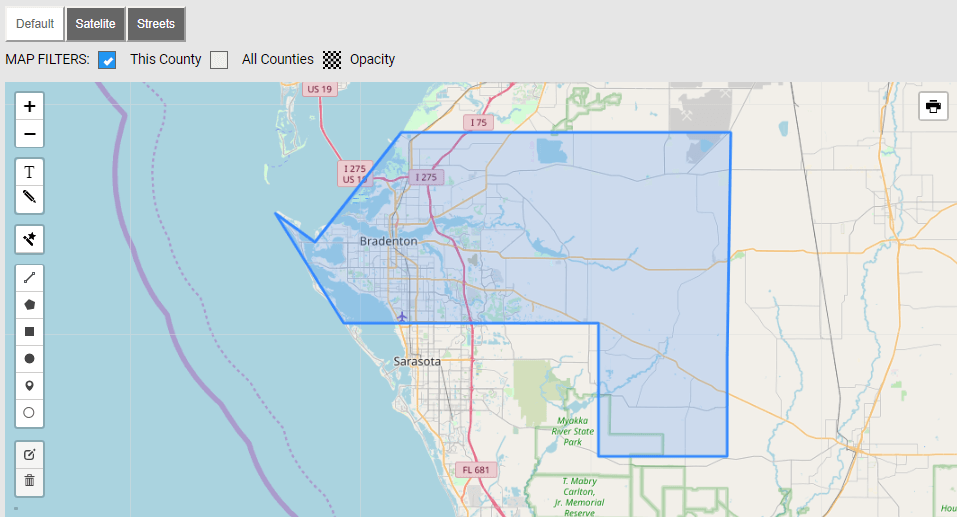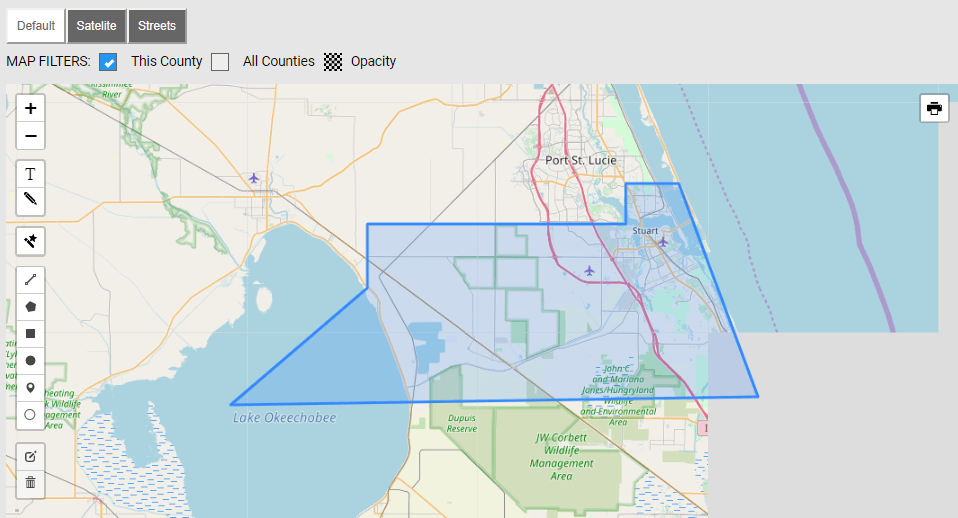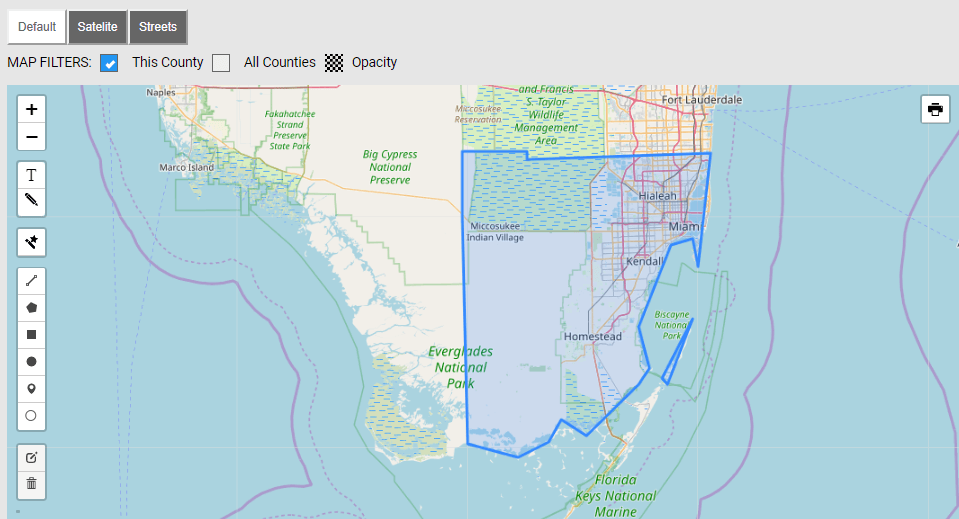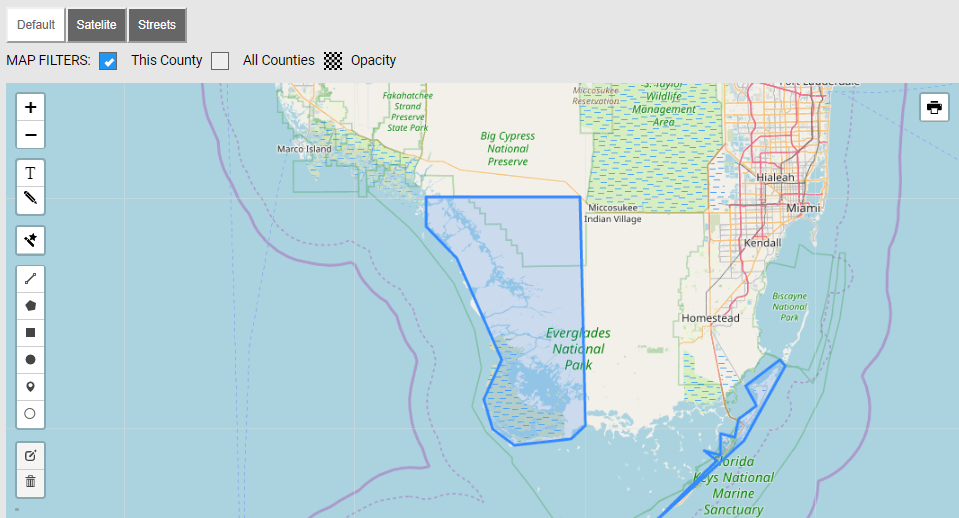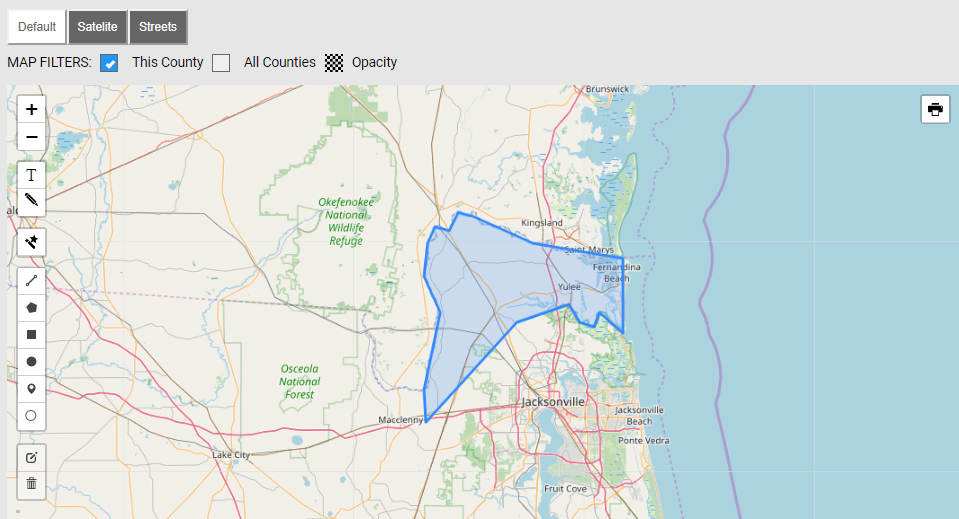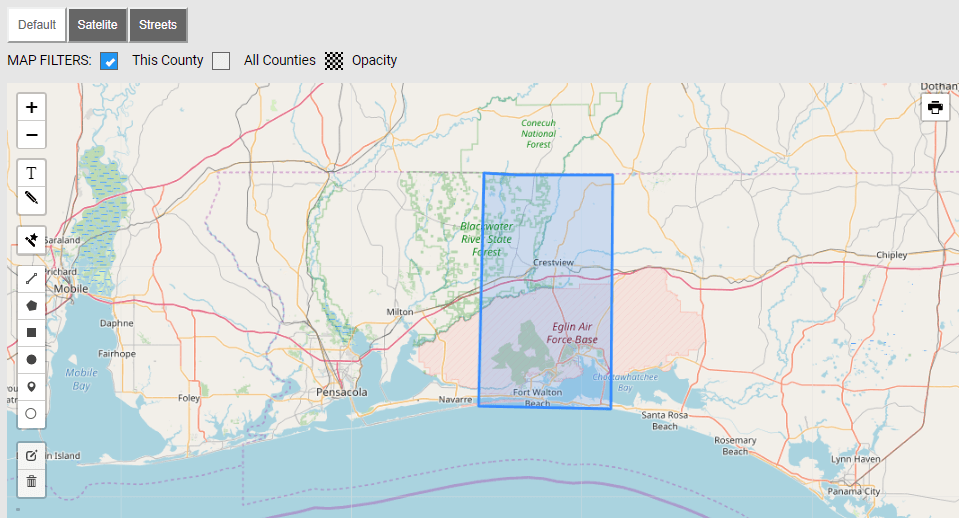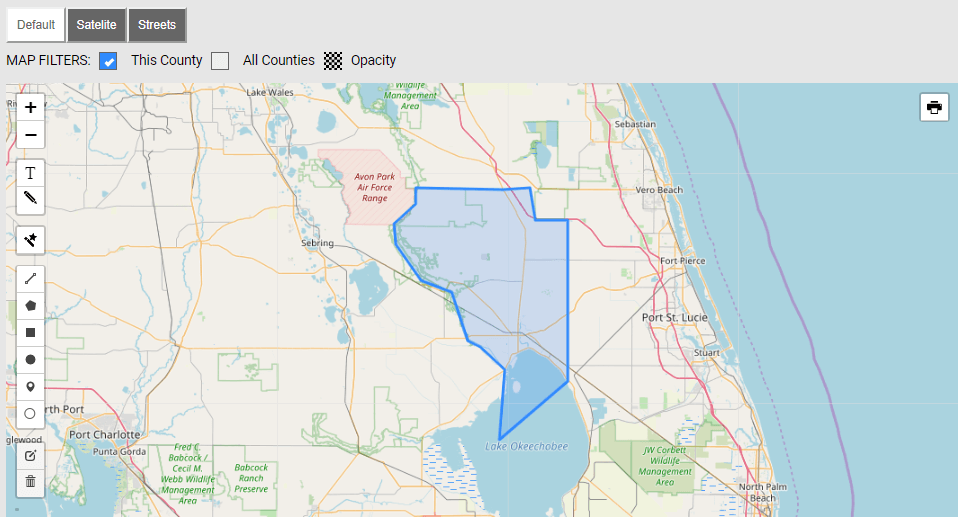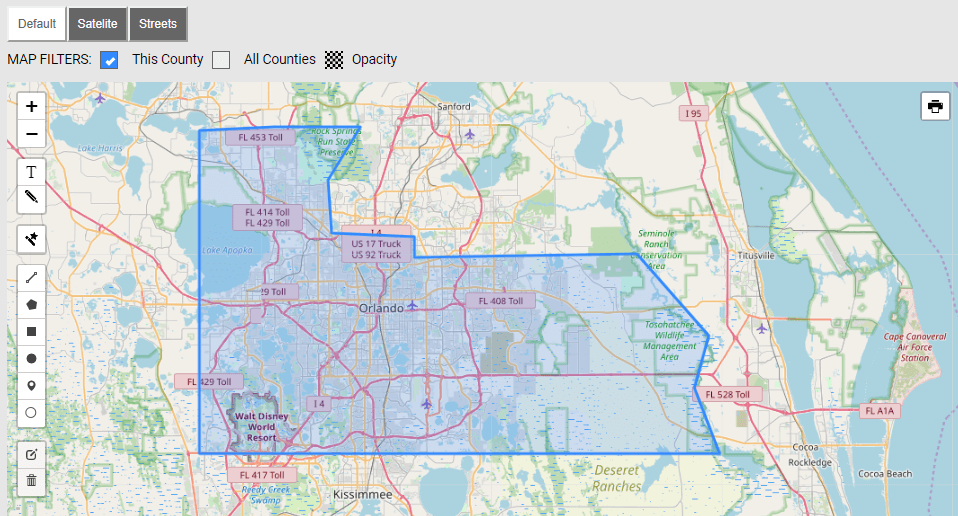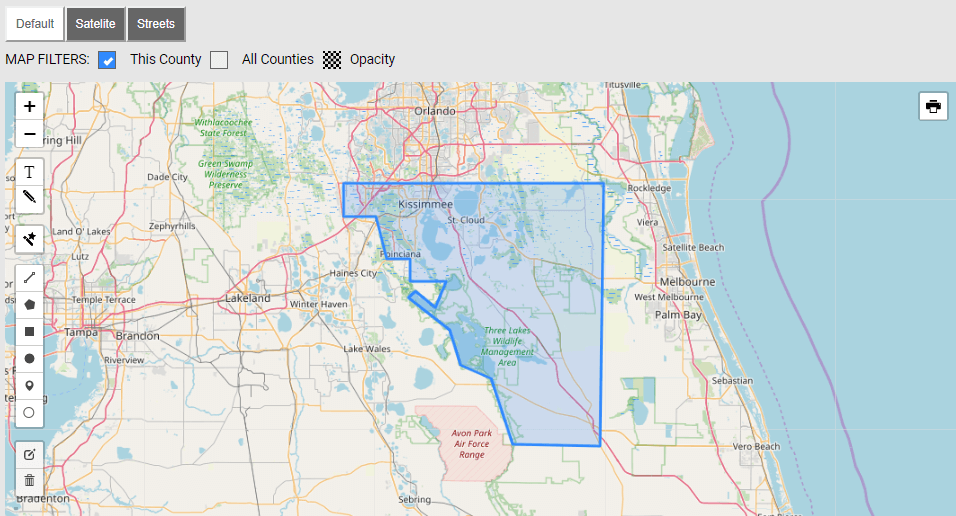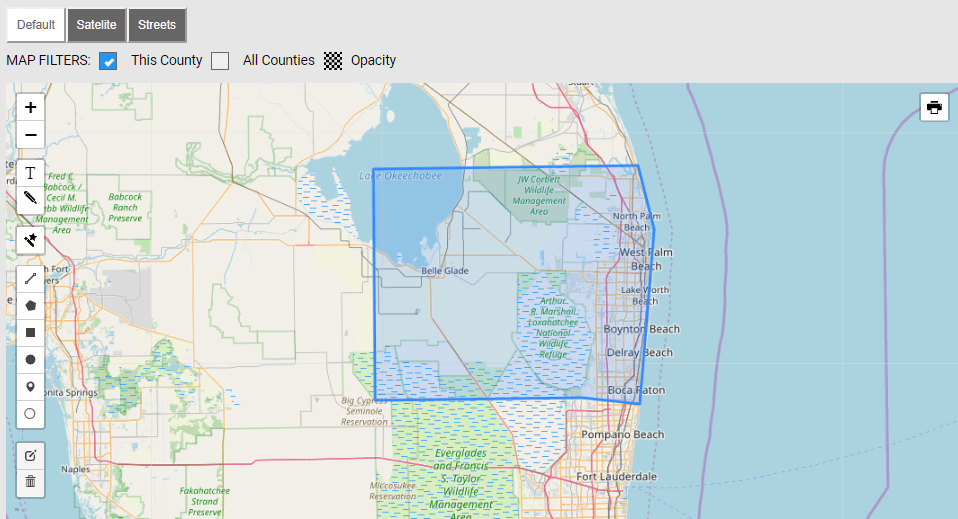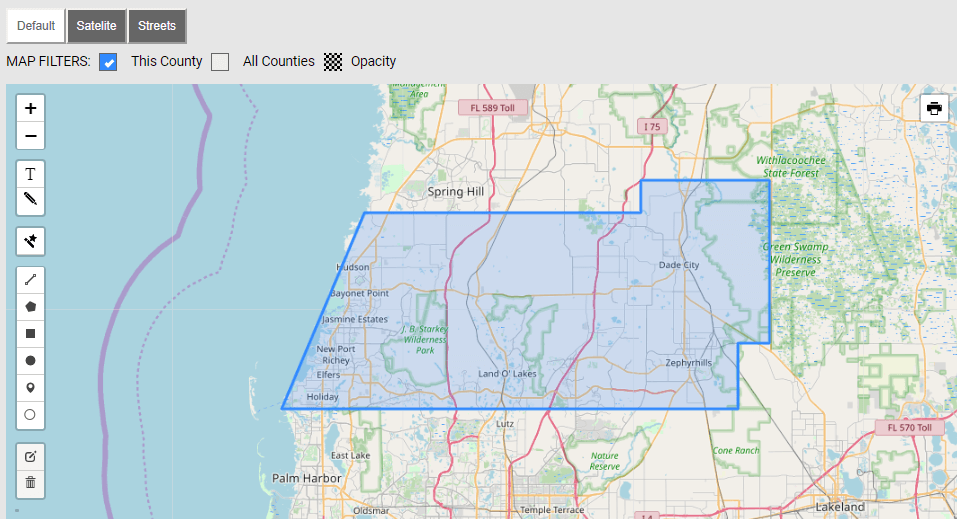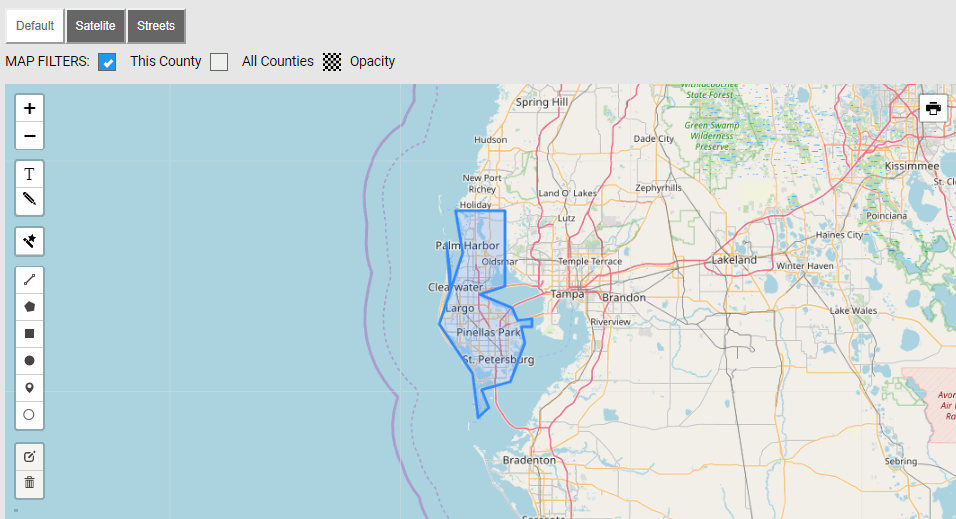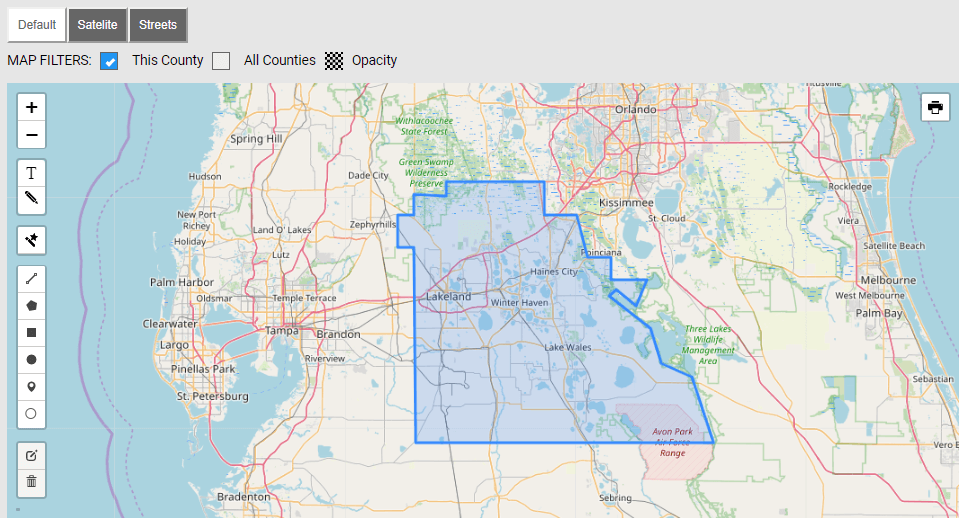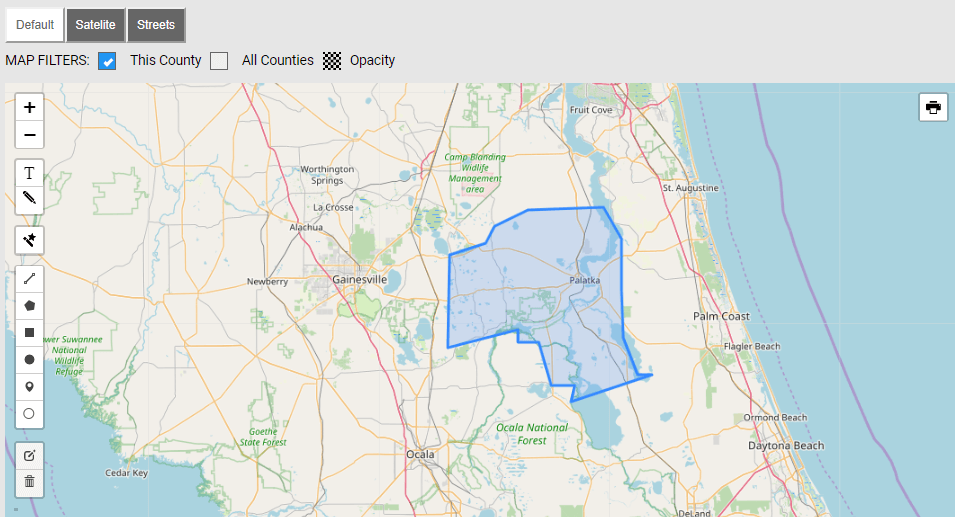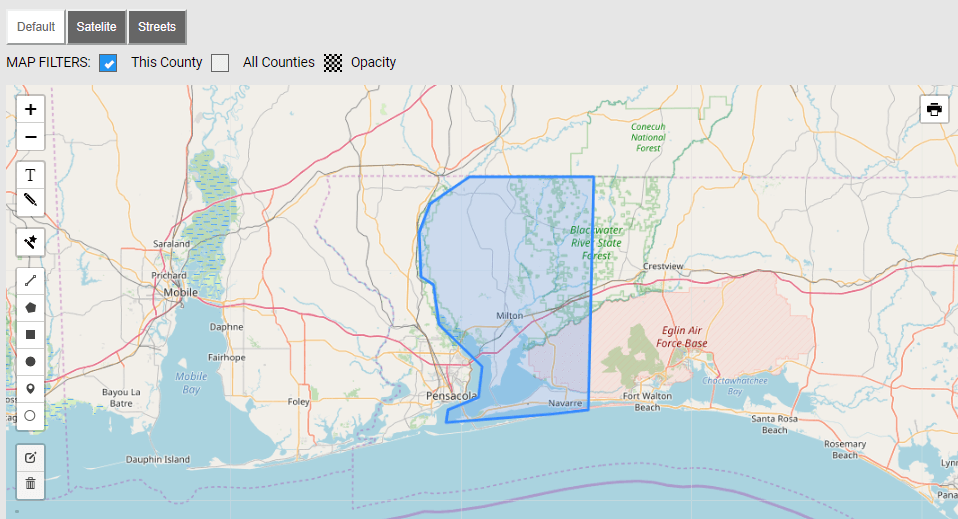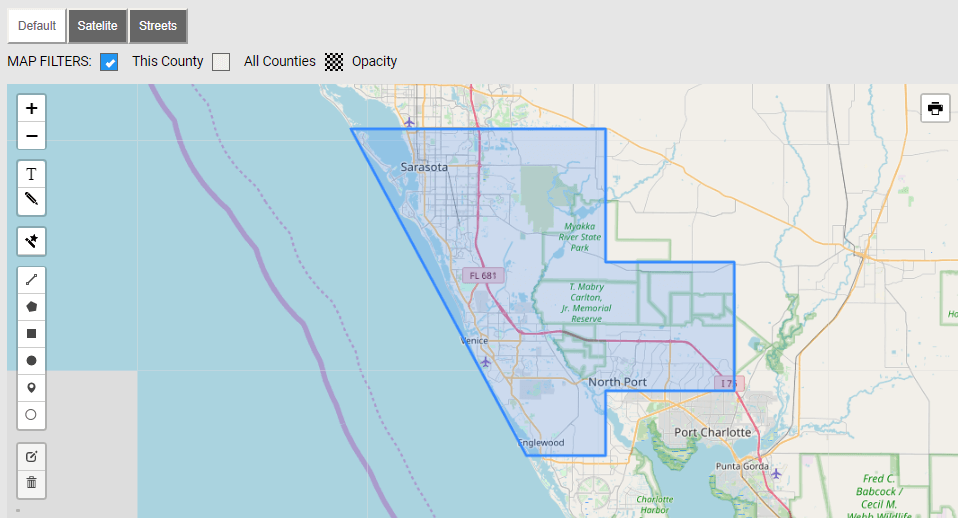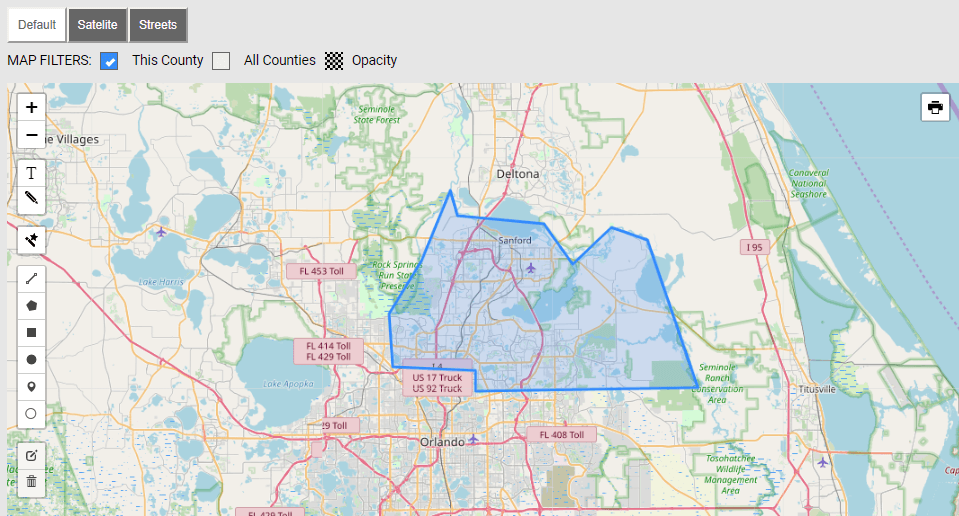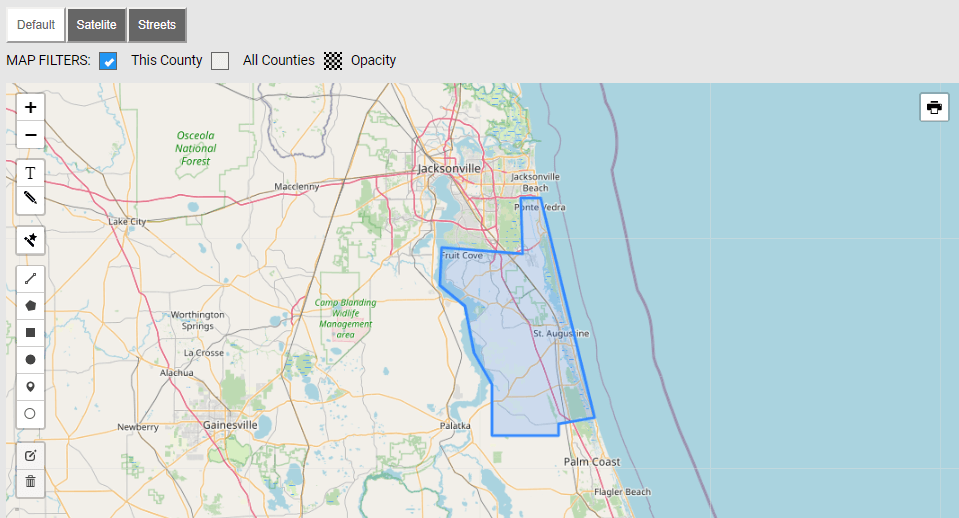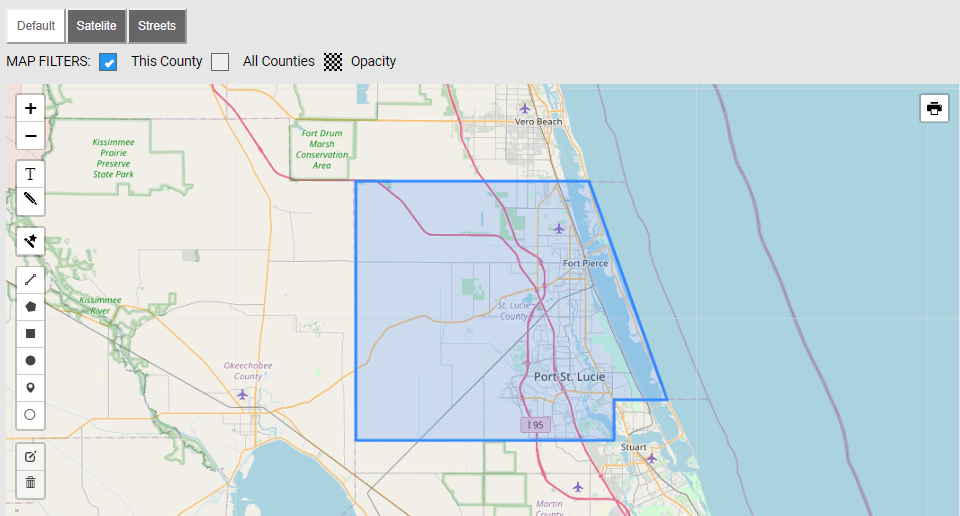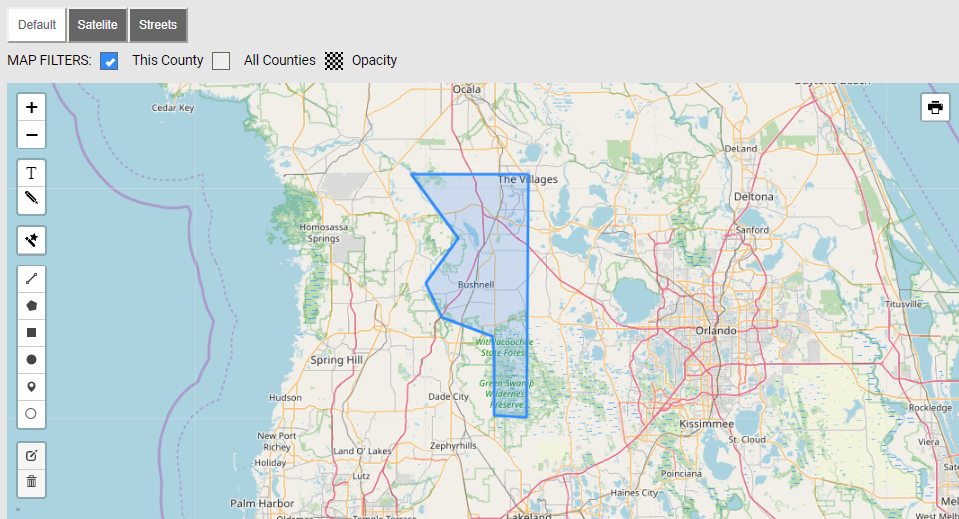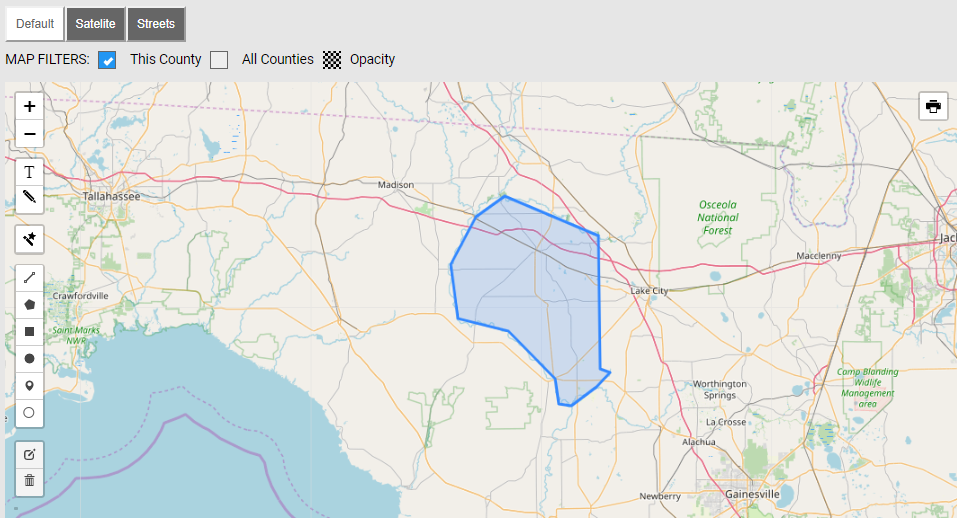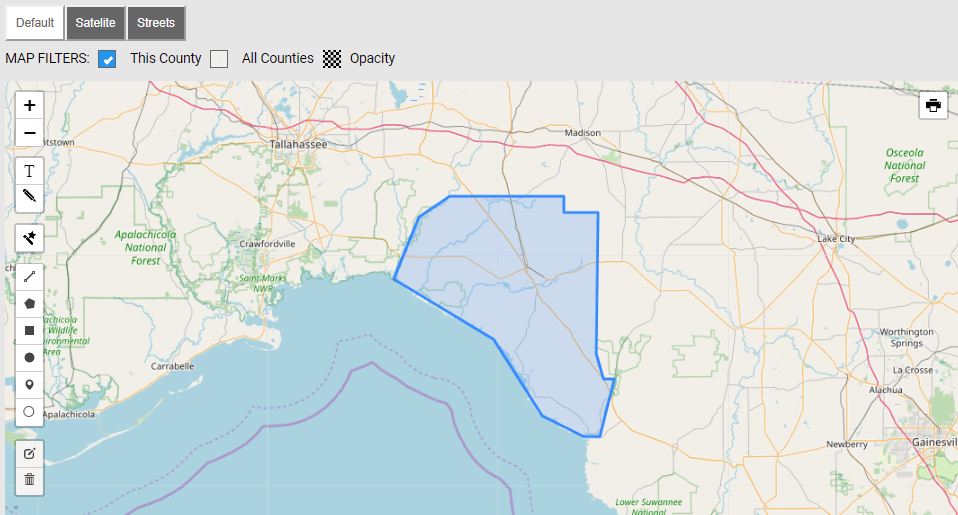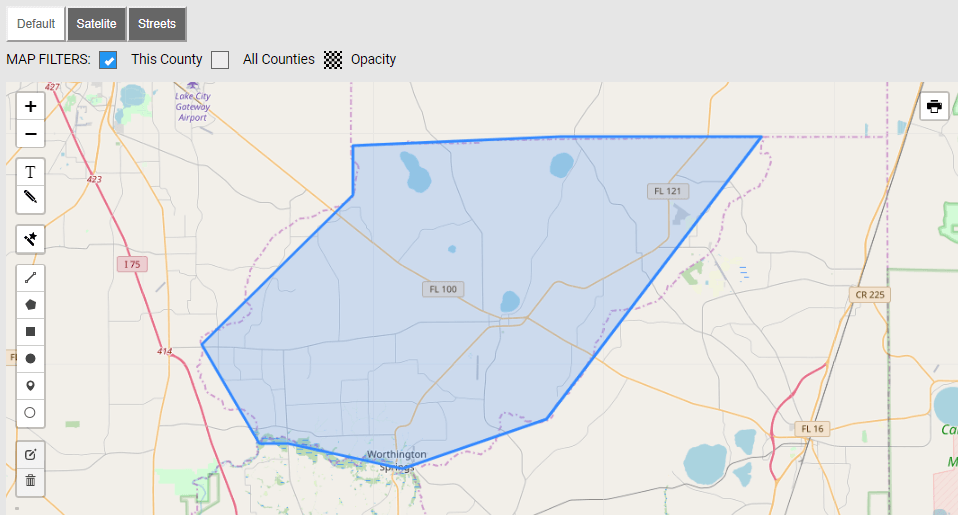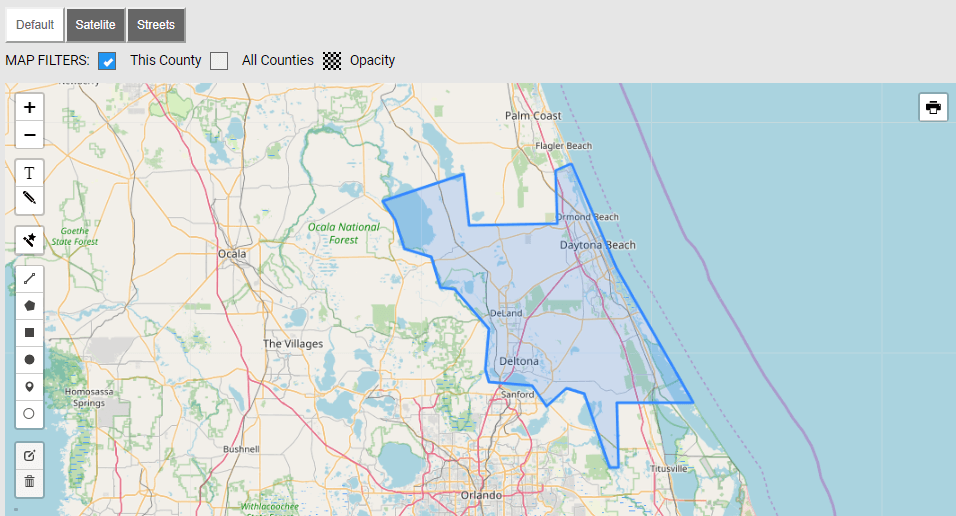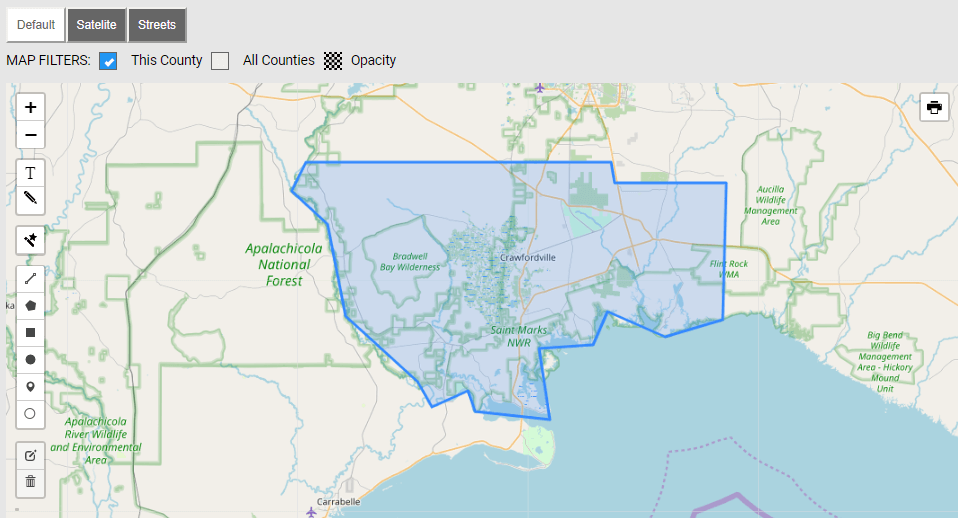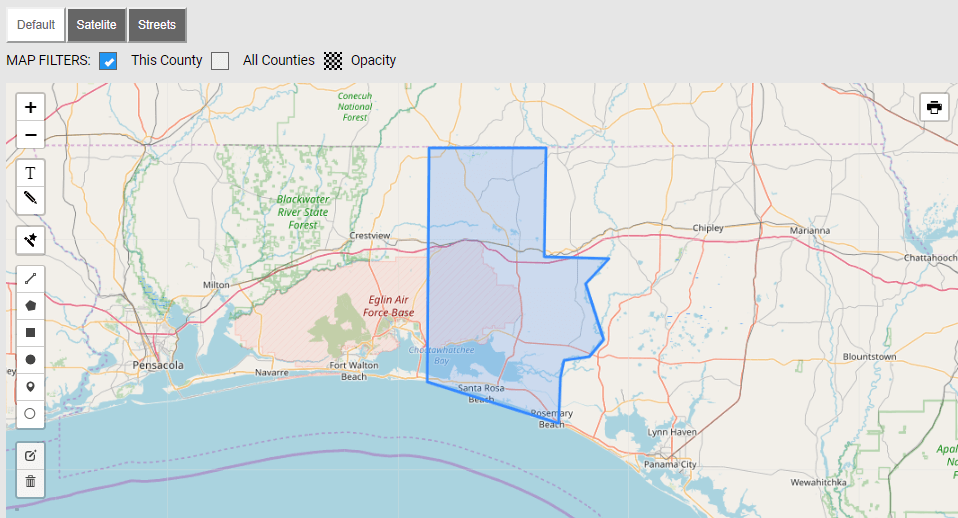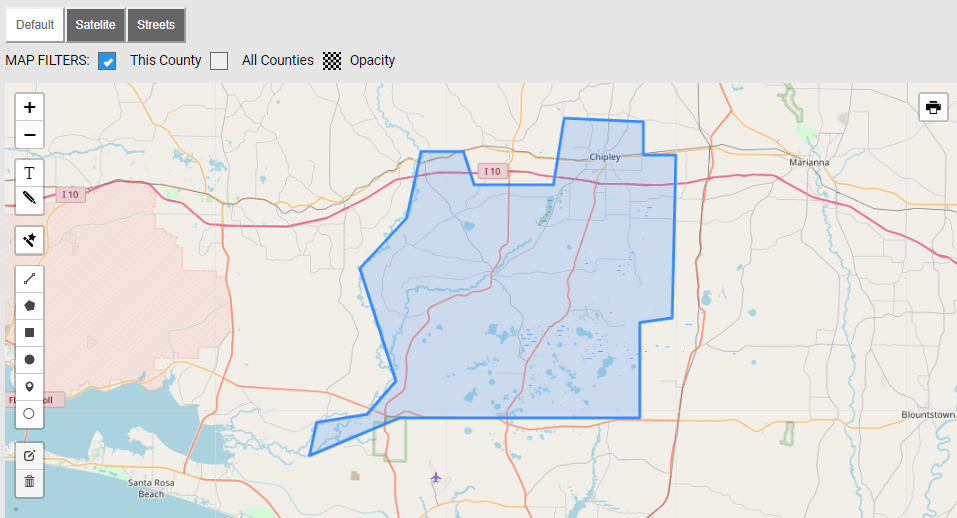Many Florida government and Florida county resources are buried among .gov websites and pages that no one can find.
We created this ultimate resource roundup for the state of Florida and all Florida counties to put all the resources in one place, allowing you to find exactly what you need, quickly.
Here you’ll be able to find:
Florida Government Resources for Consumers, such as employment, taxes, public records, clerk of courts, real estate records, and Florida government benefits programs.
Let’s get started.
Click on a Chapter to Jump to that Section:
- Florida Counties and Maps
- Florida Trackers
- Florida Employment Resources
- Florida Government Job Assistance Programs
- Free Resources to Help You Find a Job in Florida
- Unemployment in Florida
- Community Services Block Grant Program
- Florida Public Records
- Where can I get access to Florida Public Records?
- Can I Access Florida Public Records for Free?
- What Florida Records are Considered Public Records?
- What Florida Records are Not Considered Public Records?
- Where Can I Find Florida Property and Land Records?
- Florida Counties Public Records Lookup Database
- Florida Drivers License Records
- Florida Background Check
- Florida VIN and Vessel Records Lookup
- Florida Marriage Records
- Florida Divorce Records
- Florida Death Records
- Florida Criminal and Arrest Records
- Florida Court Case Records
- Florida Clerks of Court List
- Florida Real Estate, Property & Deed Records
- How To Look Up A Florida Property Deed:
- How to Find Property Tax Records and Appraisal in Florida
- Florida Property Deed & Record Search for All Counties:
- Florida Quit Claim Deeds
- Florida DMV Guide (What You Need to Know)
- Registering Your Vehicle in Florida
- Florida Vehicle Standards
- Florida Emissions Testing
- How to Register Your Vehicle in FL (Fast and Easy)
- Renewing Your Vehicle Registration
- How To Sell a Vehicle in Florida (Legally)
- Get a Florida Drivers License
- What Class of Drivers License Do I Need in FL
- How to Transfer Your Drivers License to FL
- How to Get a FL Drivers License (For New Drivers)
- How to Get a FL Drivers Motorcycle License
- How to Get a FL International Drivers License
- Florida Drivers License Test and Check
- How to Renew Your Florida Drivers License
- How to Get a Replacement Florida Drivers License
- Florida Consumer Licenses (What You Need)
- How to Get a Florida Marriage License
- How to Get a Florida Boating License
- How to Get a Florida Fishing License
- How to Get a Florida Hunting License
- How to Get a Florida Concealed Carry Permit
- Florida Taxes (What You Need to Pay)
- Florida Sales Tax
- Florida Income Tax
- Florida Property Taxes
- Florida Tax Exemptions (That You Need to Know)
- How To Establish Florida Residency (The Easy Way)
- Florida Residency Requirements
- Steps to Get Florida Residency (Quickly)
- How to Get Florida Residency (For Part Time Living Arrangements)
- Florida Child Support
- FL Child Support Guidelines
- FL Child Support Calculator
- What Child Support Covers (and Doesn’t Cover)
- How to File for FL Child Support (and Start Getting It)
- How to Pay Child Support in Florida
- Get Help: Free Child Support Resources for Florida
- Florida Health Resources
- When Should I File a Complaint on a Restaurant or Business?
- How to File a Complaint or Report on a Florida Business
- Common Florida Laws (That You Need to Know)
- Florida Traffic Laws (Common Violations)
- Texting and Driving in FL
- Cell Phone Use While Driving in FL
- Drunk Driving in FL
- Drunk Boating in FL
- Reckless Driving in FL
- Leaving the Scene of an Accident in FL
- Speeding Violations in FL
- Red Light and Stop Sign Violations in FL
- Careless Driving in FL
- Improper Lane Change
- Failure to Yield
- Get Help With Your Florida Traffic Ticket (Free Resource List)
- Florida Divorce Laws
- Florida Government Assistance and Benefits Programs (Ultimate Guide)
- FL Benefits Programs for Veterans (2020)
- FL Benefits Programs for Disabled (2020)
- FL Benefits Programs for Seniors and Retirees (2020)
- FL Benefits Programs for Minorities (2020)
- FL Benefits Programs for Immigrants and Refugees (2020)
- FL Assistance Programs for Housing (2020)
- FL Assistance Programs for Jobs (2020)
- FL Assistance Programs for Healthcare and Medical Assistance (2020)
- FL Assistance Programs for Financial Assistance (2020)
- FL Assistance Programs for Disaster Relief (2020)
- FL Assistance Programs for Education and Job Training (2020)
- FL Assistance Programs for Family and Children Services (2020)
- FL Assistance Programs for Food and Groceries (2020)
Florida Counties and Maps
If you’re looking for an interactive map of all Florida Counties, you can find that here. (Click the image to jump to the interactive map that you can also draw on)
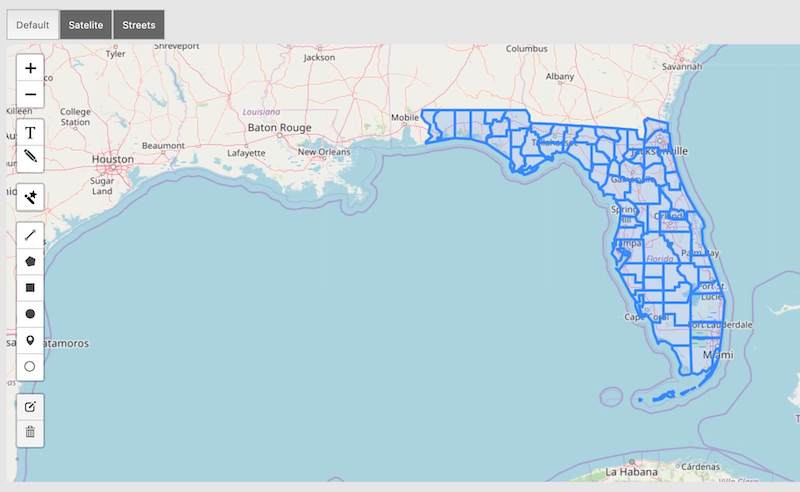
List of Florida Counties
Florida Trackers
Here is a list of interesting data trackers for the State of Florida.
Florida Employment Resources
See opportunities and land your dream job in Florida. Here is a list you can check for job openings.
Florida Government Job Assistance Programs
List of programs and resources:
- Florida Reemployment Assistance (Insurance) Program
- Florida Department of Economic Opportunity Workforce Programs
Florida Reemployment Assistance (Insurance) Program
The Federal-State Unemployment Insurance Program provides unemployment benefits to eligible workers who are unemployed through no fault of their own (as determined under Florida law, and meet other eligibility requirements of Florida law.
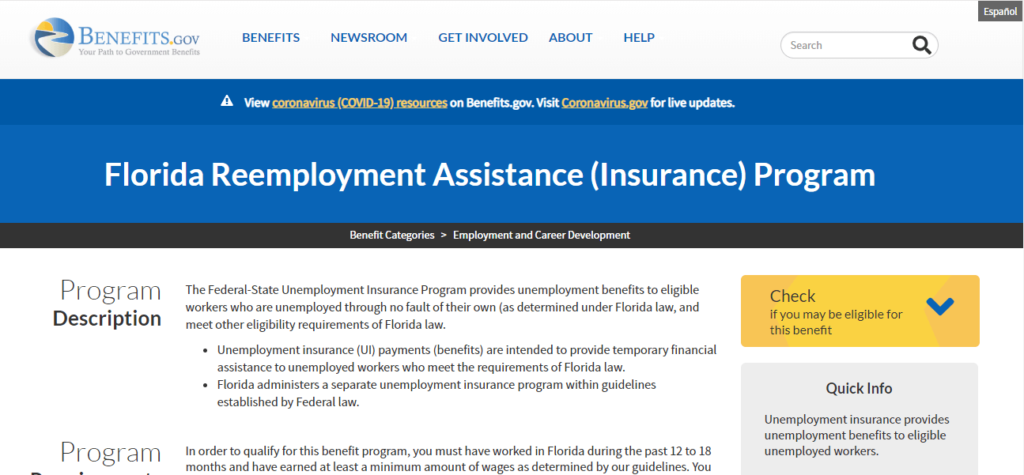
You can find that resource here here
Florida Department of Economic Opportunity Workforce Programs
Choose among the 18 programs offered by the Department of Economic Opportunity of Florida and see what category you belong to.

You can find that resource here
Free Resources to Help You Find a Job in Florida
List of programs and resources to help Florida residents find a job.
- State of Florida Careers
- Career Souce Southwest Florida
- Employ Florida
- Teach In Florida
- CareerSource Centers
State of Florida Careers
Search for a career in one of our many locations in Florida.

You can learn more here
Career Souce Southwest Florida
CareerSource Southwest Florida is an equal opportunity employer/program. Auxiliary aids and services are available upon request to individuals with disabilities.

You can learn more here
Employ Florida
Get advice about your resume, apply for jobs, and research careers. Employ Florida is your online resource for employment.

You can learn more here
Teach In Florida
This website provides many additional employment and career resources for those interested in careers in Florida’s school system.
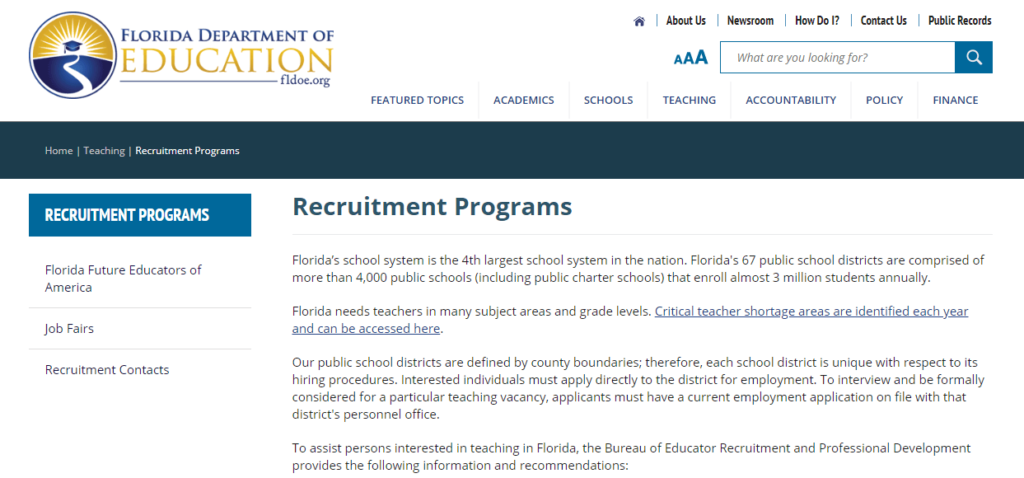
You can learn more here
CareerSource Centers
Locate the nearest CareerSource center that can help you with your job search.

You can learn more here
Unemployment in Florida
How to File an Unemployment Claim in Florida
- Prepare for Your Claim
- To apply for unemployment benefits, you will need:
- Your Social Security number
- Your driver’s license or state ID number
- Information on your employment over the past 18 months, including:
- Employer names, addresses, and phone numbers
- Dates of first and last day of work
- Gross earnings (before taxes) during employment periods
- Reason for separation
- FEIN number (on your W2 or 1099 tax forms)
- If you don’t have a FEIN, use employer details from paystub
- Some workers will need to provide additional information:
- Non-U.S. citizens must provide their Alien Registration Number or work authorization form
- Military employees must provide their DD-214 Member copy 2, 3, 4, 5, 6, 7, or 8
- Federal employees must provide SF 8 or SF 50
- Union members must provide the union’s name, hall number and phone number
- If you want to use direct deposit, you must provide your bank account number and routing number. You can also request a Reemployment Assistance debit card.
- File Your Florida Unemployment Claim
Within one week of becoming unemployed, you should begin the claims process to receive your Reemployment Assistance benefits. The date your application is finished determines when you will begin receiving benefits. Claims always begin with the Sunday prior to the completion of the application. For example, an application completed on Wednesday will take effect on the Sunday before that Wednesday.
All claims in Florida must be completed online. The process should take approximately 30-60 minutes to complete.
» File your online unemployment claim.
Here is a list of Florida programs and resources to help the unemployed.
- Low-Income Home Energy Assistance Program
- Weatherization Assistance Program
- Community Services Block Grant Program
Low-Income Home Energy Assistance Program
The Low-Income Home Energy Assistance Program (LIHEAP) is a federally funded program that helps low-income households cover heating and cooling costs. You can request assistance up to three times per year, but the program does not cover water, sewer or telephone services. The funds are paid directly to the energy company, not the household.
» Learn more about the Low-Income Home Energy Assistance Program
Weatherization Assistance Program
The Weatherization Assistance Program is another federally funded program intended to help with home energy costs for low-income households. Instead of paying for energy costs directly, this program helps with the causes of high energy costs, helping households with insulation and ventilation needs, applying solar reflective coatings and installing solar screens, and repairing or replacing inefficient air conditioners and water heaters. Not every eligible applicant will receive assistance, but you should contact your local Weatherization office to see if you qualify.
» Find a Local Weatherization office
Community Services Block Grant Program
The Weatherization Assistance Program is another federally funded program intended to help with home energy costs for low-income households. Instead of paying for energy costs directly, this program helps with the causes of high energy costs, helping households with insulation and ventilation needs, applying solar reflective coatings and installing solar screens, and repairing or replacing inefficient air conditioners and water heaters. Not every eligible applicant will receive assistance, but you should contact your local Weatherization office to see if you qualify.
» Find a Local Weatherization office
Community Services Block Grant Program
The Community Services Block Grant Program (CSBG) is designed to help members of low-income households be self-sufficient. The funds are distributed by local governments and non-profit agencies called Community Action Agencies.
These funds are used in a variety of ways to combat poverty, including:
- Providing emergency health, food, housing, day care, and transportation assistance
- Housing counseling
- Home finance management assistance
- Nutrition programs and federal surplus food distribution
- Community gardening projects
- Food banks
- Job counseling
- Placement and training services
- Homelessness prevention programs
To see if you are eligible for these benefits, contact your local CSBG provider.
» Learn more about the Community Services Block Grant Program
Florida Public Records
Accessing public records can be time-consuming especially if you don’t know how and where to get them. Here are a comprehensive list and instructions on how to get various records you might need.
Where can I get access to Florida Public Records?
To many, including myself, it can be confusing where one can get access to public records, whether you’re looking for Marriage & Divorce Records, Criminal Records, Court Cases, or Florida Property Records.
Public Government Records are usually stored at one of the following Levels:
- Federal Level
- The most common are usually Federal court cases which you can search for here. There are 94 district or trial courts in the US, and they are called U.S. District Courts. There is at least one district court in each state.
- State Level – Florida
- For Florida (state level) Court Records here are the best places to look for the records:
- Florida Supreme Court Records
- District Courts of Appeal Records
- County Level
- This is where most of the records live that citizens care about, such as marriage and divorce records, birth and death records, and criminal arrest records. Also many court case records can be found here. Refer to our search list for Florida County Public records to search the appropriate county records.
- City Level
- This is mostly for licenses and permits. For most citizen public records, refer to the Florida counties and their respective record offices.
Can I Access Florida Public Records for Free?
Yes. Public records are not considered privileged or confidential, and generally pertain to the administering of government activities. Through the Freedom of Information Act, you have access to a wide breadth of government records.
What Florida Records are Considered Public Records?
Generally speaking, public records have been filed by government agencies, or by individuals (submitted to a government agency). These include, but are not limited to:
- Marriage Records
- Divorce Records
- Property Deed, Appraisal, and Tax Records
- Criminal Arrest History Records
- Court Cases
- and many other…
What Florida Records are Not Considered Public Records?
Generally speaking, the following records are not considered Public Records:
- Records containing HIPAA protected health information
- Private company records not filed to a government agency
- Trade Secrets
- Criminal Investigation Records
- Records that have been ordered “sealed” by a court
- Certain Lawsuit Settlements
- and more…
Where Can I Find Florida Property and Land Records?
If you’re looking for Florida Property, Appraisal, or Property Tax Records, you’ll need to search the Florida county database where the property is located. These pages can be hard to find, so we compiled a list of all the Florida county property search pages here.
Florida Counties Public Records Lookup Database
To make it easy for you, we compiled all the Public Records Search links for each Florida county. Check them out below.
Florida Counties Public Records Search
Florida Drivers License Records
How to Lookup My Driving Record in Florida
- You may review the current status of your driver license online at no cost by using the Online Driver License Check.
- You may purchase your own 3-year, 7-year, or complete driver record from any driver license service center, court clerks who provide this service, or from a private vendor.
- To purchase a copy of your driver record by mail, fully complete and sign the Driver License Record Request Form and mail it to the address below with the appropriate Driver History Records fee.
- Personal information on driver records is protected by the Driver Privacy Protection Act. To obtain a copy of another person’s driver record by mail, please submit the Driver License Record Request Form, which includes the individual’s full name, date of birth or approximate age, social security number, Florida driver license number (if available) and the address where to send the record, along with the appropriate Driver History Records fee to the address below.
Bureau of Records
2900 Apalachee Parkway, MS 52
Tallahassee, Florida 32399-0575
Check or money orders should be made payable to the Division of Motorist Services. Please allow ten business days for processing.
Florida Background Check
You can do a background check on someone in Florida for $25 through the FDLE Criminal History Information Page, and get a certified copy of the report for another $25. A search will get your instant results, and may return as many as 5 possible matches, based on your criteria.
How to Do a Background Check in Florida
- Visit the Florida FDLE Criminal History Information Website
- Fill out your Name, email, and billing information
- Enter the criteria for the person on which you are completing the background check, such as: Name, Birth Date, Age, Race, Sex, or SSN
- Confirm your search criteria
- Pay the $25 for your results
- Get a list of up to 5 possible matches
- View your Florida background check results
- Order a certified copy to be shipped by mail for $25
Florida VIN and Vessel Records Lookup
How to do a VIN Check in Florida
Similarly, Florida DMV offers Vehicle Information Check. Enter the title or the VIN of your Florida-vehicle to conduct a VIN search.
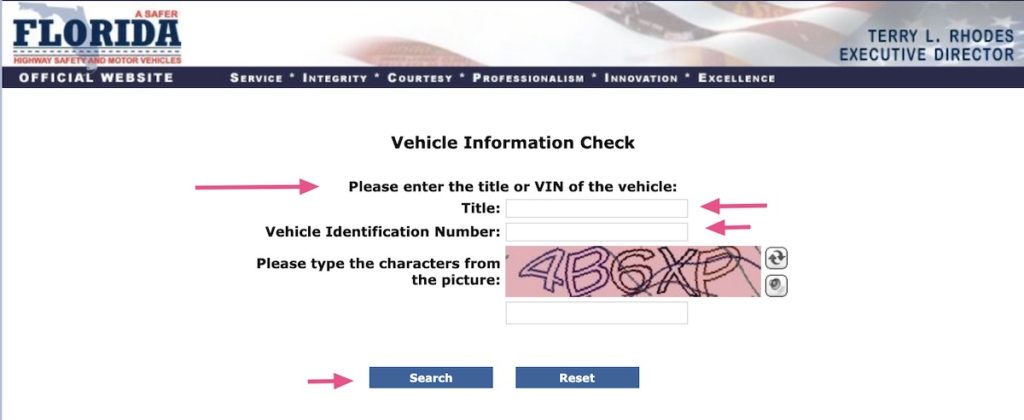
Conduct VIN search here
How to do a Florida Vessel Lookup
If you need to review documentation on a boat or another vessel, you can search for records by entering the vessel’s name or official U.S. Coast Guard identification number on the National Oceanic and Atmospheric Administration website.
The vessel documentation you will receive lists a wide range of identifying information, including the vessel’s current name, previous names, homeport, hull number and more. However, you will not receive any information classified as Personally Identifiable Information (PII).
- Go to USCG Vessel Search Page
- Enter the Vessel Name, Number, or Hull ID, and click Run Report
- In the Results, Click on the Vessel you’re interested in
- View the Vessel Details including homeport, hull number and more
Step 1.
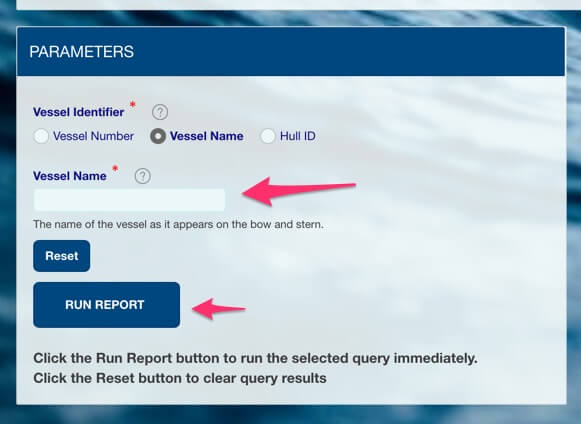
Step 2.
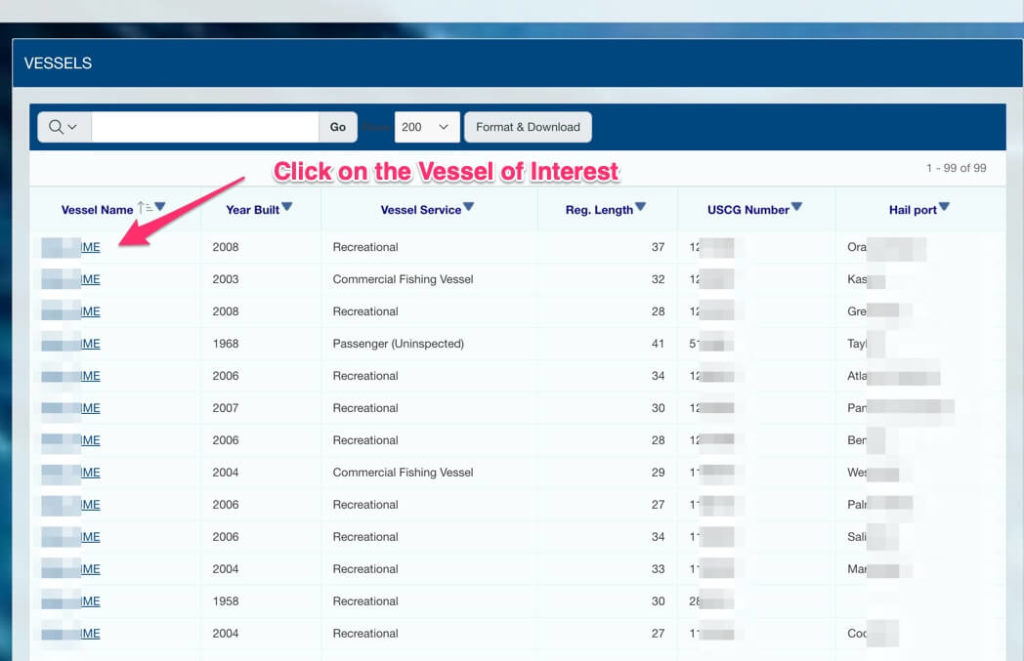
Step 3.
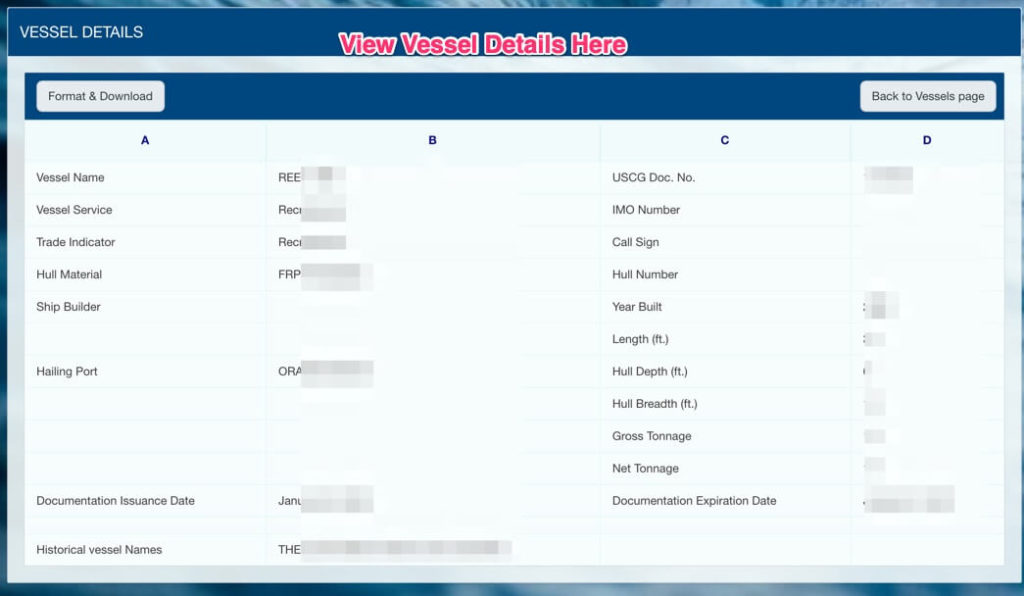
Florida Marriage Records
How to Find Marriage Records Quickly in Florida
If you need to lookup existing Florida marriage records, you need to do that by searching the appropriate Florida county records site. Find the correct Florida County Public Records site here.
If you’d like to order a copy of an existing Florida Marriage certificate, you can do that one of two ways:
- Order online with VitalChek
- Click here to order online with a credit card from VitalChek® and have your certificates delivered right to your door.
VitalChek is the only contracted vendor for the Florida Bureau of Vital Statistics. We do not recommend using any other online vendor. The application process requires you to share personal information, so security and confidentiality are critical. We can only guarantee your privacy if you order through VitalChek.
Fees:
$15 Florida Bureau of Vital Statistics fee for the first certificate (includes $5.00 search fee + $10 rush fee).
$7 VitalChek process fee to verify your identity, obtain ordering information and download your request directly to the Bureau of Vital Statistics.
$4 Additional computer-generated certification.
$2 Search fee per calendar year when the exact year is unknown (maximum fee $50.00).
UPS shipping is available for an additional fee and requires a signature upon delivery. Regular mail may be selected as a shipping method for no additional cost.
Click VitalChek® to start your online order or call VitalChek at 1-877-550-7330 to order by phone. If calling from outside the U.S., call 1-877-550-6800.
- Click here to order online with a credit card from VitalChek® and have your certificates delivered right to your door.
- Order from Florida Bureau of Vital Statistics
- The Bureau of Vital Statistics offers walk-in or mail-in services. To save time, download and complete the forms you need. The Bureau of Vital Statistics may be reached at (904) 359-6900, ext. 9000.
DH261 Application for Marriage Certificate (141K pdf)
Fees: A 5.00 search fee is included in all orders and is NON-REFUNDABLE.
$5 Search fee for one calendar year and one certified copy
$4 Additional certified copies
$2 Search fee per calendar year when the exact year is unknown (maximum fee $50.00)
$10 Rush fee (required for records prior to 1970 for same-day walk-in service, when available)
Walk-in: 1217 N Pearl Street, Jacksonville, FL 32202
Lobby hours: M-F 8:00 a.m. – 4:30 p.m.
Walk-in payments may be made in the form of cash, check, money order, Visa, and Mastercard.
Mail-in: Florida Bureau of Vital Statistics, P.O. Box 210, Jacksonville, Fl 32231-0042
Normal processing time is 3 to 5 business days for computer certificates (1970 to present) not including shipping time to and from our office. Records prior to 1970 require additional processing time.
Rush orders are given priority processing and require an additional $10 fee. Mark the outside of your envelope “RUSH”. All orders, including RUSH orders, are mailed Standard U.S. Postal delivery unless a special prepaid delivery envelope is provided.
If you are unable to access our application forms, you may submit your request in writing. Please include the following information and the proper fee.
Information about the persons named on the certificate:
Full name of both spouses prior to first marriage
Dates of Birth for each spouse
Date of Marriage
Place of Marriage (City/County)
County where license issued
Information about you (or the person requesting the certificate):
Full Name
Mailing address
Phone number
Signature of Applicant
Relationship to the person on the marriage record
Payment: Check or money order payable to “Vital Statistics”. DO NOT send cash. International payments must be made by Cashier’s Check or Money Order in U.S. Dollars drawn upon a U.S. Bank. Florida Law imposes an additional service charge of $15.00 for dishonored checks. Fees are nonrefundable, except fees paid for additional copies when no record is found. These are refunded on written request.
- The Bureau of Vital Statistics offers walk-in or mail-in services. To save time, download and complete the forms you need. The Bureau of Vital Statistics may be reached at (904) 359-6900, ext. 9000.
Florida Divorce Records
How to Find Florida Divorce Records
- How to Find Divorce Records Online
- To access the records of divorce cases in Florida, visit the website of the Clerk of the Circuit Court in the specific county where the case was heard. The website of Florida Courts provides a list of links to the websites of all Circuit Courts in Florida. To view Family Court records online, navigate to the court record access page on the county’s Circuit Court website. Requesting parties will need to register on the site and then log in to access the records portal and start searching for family law cases.
- Publicly available records are accessible from some third-party websites. These websites offer the benefit of not being limited by geographical record availability and can often serve as a starting point when researching specific or multiple records. To find a record using the search engines on these sites, interested parties must provide:
- The name of someone involved providing it is a not a juvenile
- The assumed location of the record in question such as a city, county, or state name
- Government public record search portals and third party public record websites both may provide court records search tools, which can help find divorce records, though record availability usually varies widely. Divorce records, in particular, may simply not be available through either source.
- How to Find Divorce Records In-person and By Mail
- The public can also request these records from the Offices of the Circuit Court Clerks by mail and in person. Some counties also accept requests sent by fax and delivered over the phone. To request Family Court records in person, visit the Office of the Circuit Court Clerk for the county where the case was held. This address is available online on the court’s website. Other available contact information includes the Clerk’s phone number, fax number, and email address.
- The Clerk’s Office will charge search and copy fees for requested records. Credit and debit cards are required for payment for records requested by phone and fax. For mail requests, include a check or money order for the total amount and make it out to the Clerk as instructed on the Circuit Court website. Include the following information in the request for Florida Family Court records.
- The names of the parties involved in the requested record
- The case number of the divorce
- The year or years in which the divorce was filed, heard or finalized
- The type and name of documents in question
- The dissolution of marriage documents in Florida range from between June 1927 to the present day, and are recorded by the Clerk of the Circuit Court for the county where the divorce took place. They can be gathered through the Bureau of Vital Statistics. This document contains an abstract of the information that was yielded during the judgement and is admissible as evidence that a divorce was filed and finalized. The judgement itself is gathered from the Clerk of the Circuit Court that serves the county where the divorce was issued.
- After the annulment of divorce is recorded with the clerk, the clerk then forwards a report to the Bureau of Vital Statistics for more permanent archiving. The process outlined can take about 60 days to complete. This process takes approximately 60 days. If immediate access to the divorce record is required, requesting parties may contact the County Clerk of Circuit Court where the dissolution was granted. Any dissolution made prior to June 6, 1927 is obtainable from the Clerk of Circuit Court in the county where the divorce was granted.
Florida Death Records
Who can request a Death Certificate?
- WITHOUT CAUSE OF DEATH: Any person of legal age (18 or over) may apply for a certified copy of a death record without the cause of death. The first five digits of the decedent’s social security number will be redacted.
- CAUSE OF DEATH INFORMATION: Death records less than 50 years old with the cause of death and full social security number are confidential and may only be issued to:
- Decedent’s spouse or parent;
- Decedent’s child, grandchild or sibling, if of legal age;
- Any person who provides a will, insurance policy or other document that demonstrates his or her interest in the estate;
- Any person who provides documentation that he or she is acting on behalf of any of the above-named persons;
- By Court Order
VALID PHOTO IDENTIFICATION IS REQUIRED WHEN REQUESTING CAUSE OF DEATH.
- If the applicant is not one of the above, the application must be accompanied by a notarized Affidavit to Release Cause of Death Information (DH Form 1959) signed by one of the above, along with any supporting documentation and a copy of valid photo ID of both the person authorizing release and the applicant.
- SOCIAL SECURITY NUMBER (Section 119.071 Florida Statutes): Social security numbers held by the Department of Health on death certificates are confidential and will only be issued to an eligible party requesting a confidential record, regardless of the date of death. Therefore, the first five digits of the decedent’s social security number will be redacted when issuing a public record request.
ORDERING A FLORIDA DEATH CERTIFICATE
Order Online With VitalChek
Click here to order online with a credit card from VitalChek® and have your certificates delivered right to your door.
VitalChek is the only contracted vendor for the Florida Bureau of Vital Statistics. We do not recommend using any other online vendor. The application process requires you to share personal information, so security and confidentiality is critical. We can only guarantee your privacy if you order through VitalChek.
Fees:
| $15 | Florida Bureau of Vital Statistics fee for the first certificate (includes $5.00 search fee for one calendar year + $10 rush fee). Please note: Some county health departments accept VitalChek orders, and county health department fees do vary. |
| $7 | VitalChek process fee to verify your identity, obtain ordering information and download your request directly to the Bureau of Vital Statistics. |
| $4 | Additional Certificates |
| $2 | Search fee per calendar year when exact year is unknown (maximum fee $50.00). |
UPS shipping is available for an additional fee and requires signature upon delivery. Regular mail may be selected as a shipping method for no additional cost.
Click VitalChek® to start your online order or call VitalChek at 1-877-550-7330 to order by phone. If calling from outside the U.S., call 1-877-550-6800.
Order From Florida Bureau of Vital Statistics
The Bureau of Vital Statistics offers walk-in or mail-in services. To save time, download and complete the forms you need. The Bureau of Vital Statistics may be reached at (904) 359-6900, ext. 9000.
DH727 Application for a Death Record (English PDF 55KB)
DH727S Application for a Death Record (Spanish PDF 71KB)
Fees: A 5.00 search fee is included in all orders and is NON-REFUNDABLE.
| $5 | Search fee for one calendar year and one certified copy |
| $4 | Additional certified copies |
| $2 | Search fee per calendar year when exact year is unknown (maximum fee $50.00) |
| $10 | Rush fee (required for records prior to 2009 for same day walk in service, when available) |
Walk-in: 1217 N Pearl Street, Jacksonville, FL 32202
Lobby hours: M-F 8:00 a.m. – 4:30 p.m.
Walk-in payments may be made in the form of cash, check, money order, Visa, and Mastercard.
Mail-in: Florida Bureau of Vital Statistics, P.O. Box 210, Jacksonville, Fl 32231-0042
Normal processing time for death certificates from 2009 to present is 3 to 5 business days not including shipping time to and from our office. Records prior to 2009 require additional processing time.
Rush orders are given priority processing and require an additional $10 fee. Mark the outside of your envelope “RUSH”. All orders, including RUSH orders are mailed Standard U.S. Postal delivery unless a special prepaid delivery envelope is provided.
If you are unable to access our application forms, you may submit your request in writing. Please include the following information along with a copy of your identification if requesting cause of death, payment, and any supporting documentation.
- Information about the person named on the certificate:
Full name on death recordSexDate of death (if unknown, specify range of years to be searched and provide additional fee of $2.00 per calendar year)Date of birthCity or County of deathSocial Security number
- Information about you (or the person ordering the certificate):
Full nameRelationship to decedentMailing addressPhone numberSignature of Applicant.If you are a Funeral Director or an Attorney, please provide the name of the individual you represent and their relationship to the decedent, along with your professional license number.
- Type of Certificate:
- Death certificate without cause of death (public record)
- Death certificate with cause of death (confidential for 50 years – VALID PHOTO IDENTIFICATION REQUIRED).
- Payment: Check or money order payable to “Vital Statistics”. DO NOT send cash. International payments must be made by Cashier’s Check or Money Order in U.S. Dollars drawn upon a U.S. Bank. Florida Law imposes an additional service charge of $15.00 for dishonored checks. Fees are nonrefundable, except fees paid for additional copies when no record is found. These are refunded upon written request.
- Photo Identification: Eligible applicant’s valid photo identification is required when cause of death is requested: Driver’s License, State Identification Card, Passport, Military Identification Card.
Order From Local County Health Departments
Mail-in or Walk-in to a local county health department in Florida for deaths occurring from 2009 to present only. Find a location near you, ordering information, and fees at Florida County Health Departments
Please Note: County Health Department fees vary.
Florida Criminal and Arrest Records
You can find someone’s criminal or arrest records in Florida for $25 through the FDLE Criminal History Information Page, and get a certified copy of the report for another $25. A search will get your instant results, and may return as many as 5 possible matches, based on your criteria.
How to (Instantly) Get Criminal and Arrest Records in Florida
- Visit the Florida FDLE Criminal History Information Website
- Fill out your Name, email, and billing information
- Enter the criteria for the person on which you are completing the background check, such as: Name, Birth Date, Age, Race, Sex, or SSN
- Confirm your search criteria
- Pay the $25 for your results
- Get a list of up to 5 possible matches
- View your Florida background check results
- Order a certified copy to be shipped by mail for $25
Florida Court Case Records
How to Search and Find Florida Court Case Records
If you’re interested in obtaining court case records there are a few ways to do it.
- First, you can request the records in-person. Find the Florida Clerk of Court for your county here.
- Second, you can call the appropriate Florida County by phone to request the records.
- Third, and the easiest way, is to look up the Florida court records online. Here we have compiled a list of all the links where you can look up Florida public court records online.
Florida Clerks of Court List
List of all the Clerks of Court, websites, contact info, and overview
| Court Office | Address | Phone |
|---|---|---|
| Alachua County Clerk of Court | 201 East University Ave Gainesville, Florida 32601 | 352-374-3609 |
| Baker County Clerk of Court | 339 E. Macclenny Ave. Macclenny, FL 32063 | 904-259-3686 |
| Bay County Clerk of Court | 300 E. 4th Street Panama City, FL 32401 | 850-763-9061 |
| Bradford County Clerk of Court | 945 North Temple Ave. Starke, Florida 32091 | 904-966-6280 |
| Brevard County Clerk of Court | P.O Box 219 Titusville, Florida 32781-0219 | 321-637-5413 |
| Broward County Clerk of Court | 201 S.E. 6th St. Fort Lauderdale, FL 33301 | 954-831-6565 |
| Calhoun County Clerk of Court | 20859 SE Central Avenue, Rm. 130 Blountstown, FL 32424 | 850-674-4545 |
| Charlotte County Clerk of Court | 350 E. Marion Ave Port Charlotte, FL 33950 | (941) 505-4716 |
| Citrus County Clerk of Court | 110 N. Apopka Ave. Inverness, FL 34450 | 352-341-6424 |
| Clay County Clerk of Court | 825 N. Orange Ave P.O. Box 698 Green Cove Springs, FL 32043-0698 | 904-269-6302 |
| Collier County Clerk of Court | PO Box 413044 Naples, FL 34101-3044 | 239-252-2745 |
| Columbia County Clerk of Court | 173 NE Hernando Avenue, Lake City FL. 32055 | 386-758-1342 |
| Desoto County Clerk of Court | 115 East Oak Street, Room 101 Arcadia, FL 34266 | 863-993-4876 |
| Dixie County Clerk of Court | P.O. Box 1206 Cross City, FL 32628 | 352-498-1200 |
| Duval County Clerk of Court | 501 W. Adams St. Jacksonville, FL 32202 | 904-255-2000 |
| Escambia County Clerk of Court | P.O. Box 333 Pensacola, FL 32591-0333 | 850-595-4310 |
| Flagler County Clerk of Court | 1769 E Moody Blvd, Bldg 1 Bunnell, FL 32110-0787 | 386-313-4400 |
| Franklin County Clerk of Court | 33 Market Street, Suite 203 Apalachicola, FL 32320 | 850-653-8861 850-697-2112 |
| Gadsden County Clerk of Court | P.O. Box 1649 Quincy, Florida 32351 | 850-875-8601 |
| Gilchrist County Clerk of Court | P.O. Box 37 Trenton, Florida 32693 | 352-463-3170 |
| Glades County Clerk of Court | 500 Avenue J P.O. Box10 Moorehaven, FL 33471 | 863-946-6010 |
| Gulf County Clerk of Court | 1000 Cecil G. Costin, Sr. Blvd. Rm. 148 Port St. Joe, FL. 32456 | 850-229-6112 |
| Hamilton County Clerk of Court | 207 NE 1st Street, Room 106 Jasper, FL 32052 | 386-792-1288 |
| Hardee County Clerk of Court | P.O. Drawer 1749 Wauchula, FL 33873 | 863-773-4174 |
| Hendry County Clerk of Court | P.O. Box 1760 Labelle, Florida 33975-1760 | 863-675-5217 |
| Hernando County Clerk of Court | 20 N. Main St., Room 130 Brooksville, Florida 34601-2800 | 352-754-4201 |
| Highlands County Clerk of Court | 590 South Commerce Ave. Sebring, Florida 33870-3867 | 863-402-6565 |
| Hillsborough County Clerk of Court | P.O. Box 1110 Tampa, Florida 33601-1110 | 813-276-8100 |
| Holmes County Clerk of Court | P.O. Box 397 Bonifay, FL 32425 | 850-547-1100 |
| Indian River County Clerk of Court | P.O. Box 1028 Vero Beach, Florida 32961 | 772-770-5185 |
| Jackson County Clerk of Court | P.O. Box 510 Marianna, Florida 32447 | 850-482-9552 |
| Jefferson County Clerk of Court | 1 Courthouse Circle Monticello, FL 32344 | 850-342-0218 |
| Lafayette County Clerk of Court | P.O. Box 88 Mayo, FL 32066 | 386-294-1600 |
| Lake County Clerk of Court | P.O. Box 7800 Tavares, FL 32778 | 352-742-4100 |
| Lee County Clerk of Court | P.O. Box 2469 Ft. Myers, Florida 33902 | 850-577-4000 |
| Leon County Clerk of Court | Address PO Box 1024 Tallahassee, FL 32302-1024 | 850-606-4100 |
| Levy County Clerk of Court | 355 S. Court Street Bronson, Florida 32621 | 352-486-5266 |
| Liberty County Clerk of Court | 10818 NW SR 20 P.O. Box 399 Bristol, FL. 32321 | 850-643-2215 |
| Madison County Clerk of Court | P.O. Box 237 Madison, FL 32341-0237 | 850-973-1500 |
| Manatee County Clerk of Court | P.O. Box 25400 Bradenton, Florida 34206 | 941-749-1800 |
| Marion County Clerk of Court | Post Office Box 1030 Ocala, Florida 34478 | 352.671.5610 |
| Martin County Clerk of Court | 100 East Ocean Boulevard, Suite 200 Stuart, Florida 34994 | 772-288-5576 |
| Miami-Dade County Clerk of Court | 73 West Flagler Street, Suite # 242 Miami, Florida 33130 | 305-275-1155 |
| Monroe County Clerk of Court | 500 Whitehead St. Key West, Florida 33040 | 305-292-3540 |
| Nassau County Clerk of Court | 76347 Veteran’s Way Yulee, Florida 32097 | 904-548-4600 |
| Okaloosa County Clerk of Court | 101 E. James Lee Blvd. Crestview, Florida 32536 | 850-689-5000 |
| Okeechobee County Clerk of Court | 312 Northwest 3rd Street Okeechobee, Florida 34972 | 863-763-2131 |
| Orange County Clerk of Court | 425 N. Orange Avenue Orlando, FL 32801 | 407-836-2000 |
| Osceola County Clerk of Court | 2 Courthouse Square, Suite 2000 Kissimmee, FL 34741 | 407-742-3500 |
| Palm Beach County Clerk of Court | 301 North Olive Ave West Palm Beach, FL 33401 | 561-355-2996 |
| Pasco County Clerk of Court | 38053 Live Oak Ave. Dade City, Florida 33523 | 352-518-4008 |
| Pinellas County Clerk of Court | 315 Court Street Clearwater, Florida 33756 | 727-464-7000 |
| Polk County Clerk of Court | 255 N Broadway Ave Bartow, FL 33830 | 863-534-4000 |
| Putnam County Clerk of Court | P.O. Box 758 Palatka, Florida 32178-0758 | 386-326-7600 |
| Santa Rosa County Clerk of Court | 5841 Gulf Breeze Pkwy C Gulf Breeze, Florida 32563 | 850-983-1820 |
| St. Johns County Clerk of Court | 4010 Lewis Speedway St. Augustine, FL 32084 | 904-819-3600 |
| St. Lucie County Clerk of Court | P. O. Box 700 Fort Pierce, Florida 34954 | 772-462-6900 |
| Sarasota County Clerk of Court | 2000 Main Street Sarasota, FL 34237 | 941-861-7400 |
| Seminole County Clerk of Court | 301 N. Park Avenue P.O. Box 8099 Sanford, FL 32772 | 407-665-4450 |
| Sumter County Clerk of Court | 215 E McCollum Avenue Bushnell, FL 33513 | 352-569-6600 |
| Suwannee County Clerk of Court | 200 S. Ohio Ave. Live Oak, Florida 32064 | 386-362-0500 |
| Taylor County Clerk of Court | P.O. Box 620 Perry, FL 32347 | 850-838-3506 |
| Union County Clerk of Court | 55 West Main Street Union County Courthouse Rm 103 Lake Butler, FL 32054 | 386-496-3711 |
| Volusia County Clerk of Court | P.O. Box 6043 Deland, Florida 32721-6043 | 386-736-5915 |
| Wakulla County Clerk of Court | 3056 Crawfordville Hwy Crawfordville, FL 32327 | 850-926-0905 |
| Walton County Clerk of Court | P.O. Box 1260 DeFuniak Springs, Florida 32433 | 850-892-8115 |
| Washington County Clerk of Court | P.O. Box 647 Chipley, FL 32428 | 850-638-6289 |
Florida Real Estate, Property & Deed Records
A property owner can simply request, from the County recorder, a certified copy of the document either in person, or by mail. A certified copy has the same legal significance as the original document.
If requested by mail, the party requesting the document must enclose a check for applicable fees, payable to the County, and provide the book and page number where the document is located. If the book and page number where the document is located is unknown, then the County will charge an additional records search charge to find the Deed.
How To Look Up A Florida Property Deed:
In order to look up a Florida Deed, you will need to first determine the name of the county where the property is located. For example, if you need to find a property in the City of Davie, Florida, then you will look in Broward County public records. Next, you navigate to the county public records website that corresponds with the county of where the property is located. Each Florida County has a free search engine for public records. Below you can find links to each counties search engine.
How to Find Property Tax Records and Appraisal in Florida
- As a homeowner, you pay property taxes to the county where your home sits. Property taxes are paid directly to the county assessors or through your mortgage escrow company with a prorated amount included in your monthly mortgage payment. To determine the exact amount owed and determine if taxes are paid appropriately, you have several places to check, however, use our list below to find the correct link for your county.
Florida Property Deed & Record Search for All Counties:
Florida Quit Claim Deeds
How to File a Quit Claim Deed in Florida
- Fill in the deed form.
- Print it out.
- Sign in front of two witnesses and get all signatures notarized.
- Make a photocopy for each party to the transaction.
- Check the stamp tax and recording fees in your county.
- Record the document at the county clerk’s office.
Florida DMV Guide (What You Need to Know)
Registering Your Vehicle in Florida
Florida Vehicle Standards
list of the standards. Don’t make this too long, but basic overview with the most important items.
Brakes:
Your car must have two braking systems. Each must be able to stop the car alone. The parking or emergency brake should be strong enough to hold the car on any hill. Your brakes must be able to stop your car within the distance shown on the chart on the right.
Braking Distance
You must be able to stop your car within the distance shown by the black cars when you use the foot brake. For safest driving, keep your brakes in such good condition that you can stop within distance shown by the white cars.
It is important to note that the graph below illustrates the braking distance AFTER YOU HAVE APPLIED YOUR BRAKES. To this must be added a REACTION DISTANCE, which is the distance you travel from seeing the danger to putting your foot on the brake pedal. Since 3/4 second is the average reaction time, a motorist will travel 11 feet for each 10 m.p.h. of speed before hitting the brake. At 50 m.p.h. this distance would be 55 feet!
Lights:
Your car must have the following lights:
- Bright (high-beam) headlights which show objects 450 feet ahead.
- Dimmed (low-beam) headlights which show objects 150 feet ahead.
- Two red taillights mounted on the rear, visible from 1,000 feet.
- A white light that makes the license plate visible from 50 feet (The plate must be kept clean).
- Two red stoplights. They must be seen from 300 feet in the daytime, and must come on when the foot brake is pressed.
All vehicles, including animal-drawn vehicles, must have at least one white light visible from a distance of not less than 1,000 feet to the front. They must also have two red lights visible from a distance of not less than 1,000 feet to the rear, or one red light visible to the rear for a distance of 1,000 feet and two red reflectors visible from all distances from 600 feet to 1,000 feet.
Other Equipment Standards
Horn: Your vehicle must have a horn which can be heard from a distance of 200 feet.
Windshield Wiper: Your vehicle must have a windshield wiper in good working order for cleaning rain, snow or other moisture from the windshield.
Windshields: Must be safety glass and may not be covered or treated with any material which has the effect of making the windshield reflective or in any way non-transparent. It must be free of any stickers not required by law.
Side windows: May not be composed of, covered by, or treated with any material which has a highly reflective or mirrored appearance and reflects more than 35% of the light.
Rear windows: When the rear window is composed of, covered by, or treated with any material which makes the rear window non-transparent, the vehicle must be equipped with side mirrors on both sides.
Directional signals: You must have electrical turn signals if your vehicle measures more than 24 inches from the center of the top of the steering post to the left outside limit of the body, or when the distance from the steering post to the rear of the body or load is greater than 14 feet.
Tires: Your tires should have visible tread of at least 2/32 of an inch across the base with no worn spots showing the ply. Smooth tires on wet roads contribute to thousands of serious crashes.
Mirrors: Your car must have at least one rearview mirror which gives a view of the highway at least 200 feet to the rear
Florida Emissions Testing
Basic Overview of Requirements
How (and Where) to Get Emission Testing in Florida
- In the 1990s, the state of Florida abolished all vehicle emissions test requirements. Currently, there are no vehicle emissions test requirements to register a vehicle in the State of Florida. Jeb Bush, the Governor of the State of Florida at that time, did away with state emissions testing due to the high cost of the program – $50 million annually – and because Florida met all Federal Clean-Air Standards.
- Even though the state does not require vehicle emissions tests, vehicle owners can still get their vehicle tested at many private service stations voluntarily.
How to Register Your Vehicle in FL (Fast and Easy)
Steps to Register Your Vehicle in Florida
- Visit a Florida Department of Highway Safety and Motor Vehicles office (DHSMV)
- Have your title and ID with you and show proof of Florida insurance.
- If you haven’t done it yet, have a VIN inspection and odometer reading done on-site.
- Pay the initial vehicle registration fee of $225, plus taxes, plate and title fees.
Renewing Your Vehicle Registration
Steps to Renew Your Vehicle in Florida
- Online License Renewal
- Online renewal is the most convenient way to renew your driver’s license. However, there are some restrictions.
You cannot renew your Florida driver’s license online if:- You last renewed your license online, by mail or over the phone
- You are not a U.S. citizen or permanent resident
- You are renewing a Commercial Driver’s License (CDL)
- Online renewal is the most convenient way to renew your driver’s license. However, there are some restrictions.
- In-Person License Renewal
- You can go to a Florida Department of Highway Safety and Motor Vehicles (FLHSMV) location to renew your license. Visit the FLHSMV website to find a full list of driver’s license service centers in your county.
The requirements to renew your Florida driver’s license in person include:- You must turn in your current license
- You must pass a vision test
- You must provide two approved documents for proof of address if your address has changed
- If your name has changed, you must provide approved documents that establish your new name.
- If you have not been issued a driver’s license in person since Jan. 1, 2010, you need to bring with you one form of primary identification, two proofs of address and proof of your social security number.
- See the FLHSMV What to Bring page for more details on the approved forms of documentation required for renewal. Documentation requirements may be different if you are Canadian, an immigrant or a nonimmigrant (a person staying in the United States temporarily).
- You can go to a Florida Department of Highway Safety and Motor Vehicles (FLHSMV) location to renew your license. Visit the FLHSMV website to find a full list of driver’s license service centers in your county.
- Renewal for Seniors and Older Drivers
- If you are 80 years of age or older, you must renew your license every six years. You are also required to pass a vision test to renew. You can take the test at a FLHSMV location during the license renewal process, but you may be able to take the test in other locations. See the Official Florida Driver License Handbook or contact the FLHSMV for more information.
List of programs and resources here.
- Resource 1 Title
- Resource 2 Title
Resource 1 Title
Resource 1 Overview and/or Quick Instructions
Resource 1 Image Snapshot
You can find Resource 1 here
How To Sell a Vehicle in Florida (Legally)
Steps Required to (Legally) Sell a Vehicle in Florida
- Apply for a demonstration only temporary tag, if needed;
- Conduct a VIN inspection, if necessary;
- Record odometer reading on title;
- Complete title transfer in a motor vehicle service center;
- Remove license plate from the sold vehicle;
- Surrender the license plate, if applicable; and
- File a Notice of Sale, form HSMV 82050.
A Florida Bill of Sale is a document that legally transfers a person’s ownership interest in an item to another person or business. Depending on the item, a Florida Bill of Sale must include certain information. However, any bill of sale used in Florida must contain the name and address of both the buyer and seller and the purchase price. It also needs to be signed by the seller and sometimes the buyer and seller. Some Florida Bills of Sale must be notarized.
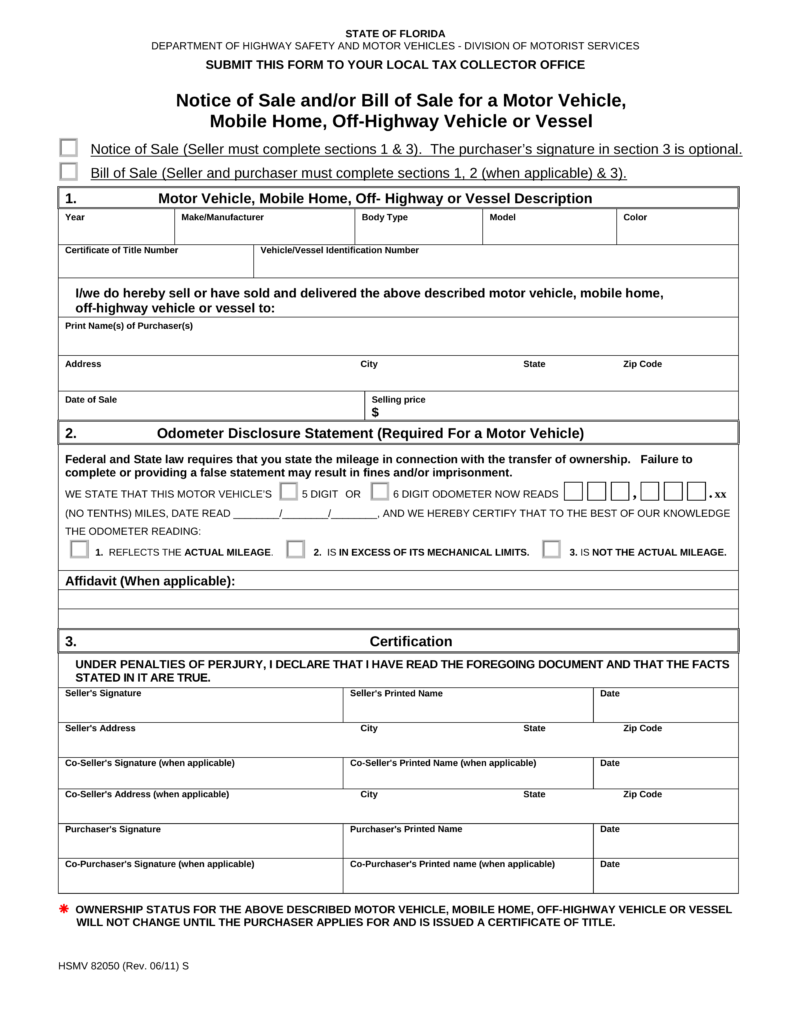
You can download here.
Florida Vehicle Bill of Sale Required Items
- Apply for a demonstration only temporary tag, if needed;
- Conduct a VIN inspection, if necessary;
- Record odometer reading on title;
- Complete title transfer in a motor vehicle service center;
- Remove license plate from the sold vehicle;
- Surrender the license plate, if applicable; and
- File a Notice of Sale, form HSMV 82050.
Get a Florida Drivers License
What Class of Drivers License Do I Need in FL
- NON-COMMERCIAL DRIVER LICENSES
CLASS E: Any non-commercial motor vehicles with Gross Vehicle Weight Rating (GVWR) less than 26,001 pounds, including passenger cars, 15 passenger vans including the driver, trucks or recreational vehicles and two or three-wheel motor vehicles 50 cc or less, such as mopeds or small scooters. (see below). Farmers and drivers of authorized emergency vehicles who are exempt from obtaining a commercial driver’s license must obtain a Class E driver license.
Class E driver license restrictions for individuals under 21:
- 16 year olds can only drive between 6 a.m. and 11 p.m., unless accompanied by a licensed driver who is at least 21 years old and occupies the front passenger seat, or the driver is traveling to or from work.
- 17 year olds Can only drive between 5 a.m. and 1 a.m., unless accompanied by a licensed driver who is at least 21 years old and occupies the front passenger seat, or the driver is traveling to or from work.
CLASS E Learner’s License: Motor vehicles less than 8,000 pounds
- A learner’s license has the following conditions:
- Must have a licensed driver at least 21 years old occupying the closest seat to the right of the driver;
- Can only drive during daylight hours during the first three months from the original issue date and until 10:00 p.m., thereafter; and
- Are not allowed to operate motorcycles.
2. MOTORCYCLES
For those authorized to operate a motorcycle, the following abbreviation will appear on the front of the driver’s license under the expiration date: MOTORCYCLE ALSO or MOTORCYCLE ONLY.
3. MILITARY
For military servicemembers and families, important information and assistance is available here.
4. COMMERCIAL DRIVER LICENSES (CDL)
CLASS A: Trucks or truck combinations weighing with a Gross Vehicle Weight Rating of 26,001 lbs. or more, provided towed vehicle is more than 10,000 lbs.
CLASS B: Straight trucks weighing 26,001 lbs. Gross Vehicle Weight Rating or more.
CLASS C: Vehicles transporting placardable amounts of hazardous materials, or vehicles designed to transport more than 15 persons including the driver with a Gross Vehicle Weight Rating of less than 26,001 lbs.
How to Transfer Your Drivers License to FL
For Adult drivers who already have a license in another state (List the steps)
Steps to Quickly Transfer Your Drivers License to Florida
Applications for driver’s licenses/ID cards must be made in person at any local office offering driver licenses services. When applying for a driver license, you will be given a vision test, however you may be eligible to receive a license without taking a written or road test.
The fee for an initial Florida Class E license (including learner’s permit) is $48.00, a commercial driver’s license (Class A) license is $75.00 and endorsements are $7.00 each. The fee for an ID Card is $25.00. Most local Tax Collector offices also charge a $6.25 service fee. For a complete list of driver license fees, click here.
List of programs and resources here.
- Required Documentation
- Title/Registration
Required Documentation
For a list of the required documentation you will need to obtain a Florida driver license or Florida ID card, please click on your applicable residency status below:
U.S. Citizen
Immigrant
Non-Immigrant
Canadian
Title/Registration
For vehicles with a lien:
- If the out-of-state title is currently in the possession of an out-of-state lienholder, you must contact the lienholder to request that the title be transferred to Florida.
- Regardless of whether the lienholder will transfer the title to Florida or not, you must have your vehicle registered.
- If the lienholder refuses to transfer title from the previous state, request for them to send that to you in writing on letterhead. Once you obtain that letter, you may bring it to a motor vehicle service center to apply for a registration.
- If the lienholder agrees to have the title transferred to Florida, you may visit a local motor vehicle service center to complete the Application for Certificate of Title With/Without Registration (HSMV form 82040).
For vehicles without a lien:
- Prepare a packet containing the following: (Please note: special circumstances may require additional documentation.)
- Proof of identity (required for all owners)
- Proof of Florida insurance
- Original out-of-state title
- When applying for title, ALL owners are required to sign a completed Application for Certificate of Title With/Without Registration (HSMV form 82040).
- Verification of physical inspection of the motor vehicle’s vehicle identification number (VIN), completed on an Application for Certificate of Title With/Without Registration (HSMV form 82040) or Vehicle Identification Number and Odometer Verification (HSMV form 82042). The VIN must be physically inspected and verified by one of the following:
- A law enforcement officer from any state.
- A licensed Florida or out of state motor vehicle dealer. If the dealer is located out of state, they must verify the completion of the VIN verification on their company letterhead.
- A county tax collector employee or Division of Motorist Services Compliance Examiner (which can be located at any local service center offering motor vehicle services).
- Provost Marshal or commissioned officer in active military service, with a rank of 2nd lieutenant or higher.
How to Get a FL Drivers License (For New Drivers)
For learners permits and those coming of age to drive (list the steps)
Requirements to get a Drivers License in FL (New Drivers)
- Complete a Traffic Law and Substance Abuse Education (TLSAE) course or an equivalent course offered by your local school board.
- Apply for the learner’s license in person at an DHSMV Driver License Service Center.
- Bring the documentation to verify the following:
- Your identity, including your full name
- Your date of birth
- Your Social Security number (or proof of ineligibility if you are not a US citizen)
- Your US citizenship (or your legal presence in the US if you are not a US citizen)
- Your residential address in Florida
- Bring the completed form Parental Consent for a Driver Application of a Minor (HSMV 71142). This form must be signed by your parent or guardian in the presence of a Driver License Service Center employee or Notary Public.
- Pass vision and hearing examinations, have your picture taken.
- Take and pass the knowledge test at the Driver License Service Center or at an authorized third-party exam provider online.
- Pay the $48 driver license fee. If your service center is part of a county tax collector office, you must pay extra $6.25.
How to Get a FL Drivers Motorcycle License
Required Steps to Quickly Get a Motorcycle Endorsement in FL
- You must hold at least a valid Class E operator’s driver’s license.
- Complete the Basic RiderCourse (BRC) or Basic RiderCourse updated (BRCu) motorcycle safety course with an authorized Sponsor.
- After successfully passing the RiderCourse, you must obtain your endorsement within (1) year. If the endorsement has not been obtained during the one (1) year grace period, the course completion card as well as the “PASS” waiver status is considered invalid and a Rider Skills Test (RST) will need to be completed with an FRTP Regional Coordinator before you may obtain the endorsement.
- After you complete the Basic RiderCourse (BRC) or Basic RiderCourse updated (BRCu), visit a driver’s license office or tax collector office that issues driver licenses and inform them that you completed the course. Upon providing proper ID and paying the required endorsement fees, your Class E license will be issued with a motorcycle endorsement.
How to Get a FL International Drivers License
Florida Requirements for International Drivers
You only need your documentation of identification, such as your driver’s license from your native country, to drive in Florida. You do not need an international driving permit.
Florida Drivers License Test and Check
Drivers License Check – What You Need to Know
The Driver License Check system can be used to review the status of certain items connected to your driver license (e.g. driver status and driver improvement school eligibility) or to update your social security number or insurance information. Parents may also access the driving history of their child with this system.
Drivers License Test – List Resources and practice tests
How to Renew Your Florida Drivers License
Steps
- Renew Online
- FLHSMV offers a quick, convenient way to renew your driver’s license or ID card online at GoRenew.com. The following driver license services are offered through GoRenew:
- Renew a driver’s license Florida offers a one-time online convenience renewal for customers. Visit GoRenew.com to see if you are eligible
- Update the address on your driver’s license or ID card.
- Replace a lost or stolen credential.
- To renew or replace a credential online, the department must verify a customer’s Social Security number. If the department is unable to verify, the customer must follow up with the Social Security Administration.
- FLHSMV offers a quick, convenient way to renew your driver’s license or ID card online at GoRenew.com. The following driver license services are offered through GoRenew:
- Renew in Office
- Customers must go into an office:
- If a customer has already used their one-time online convenience renewal.
- If a customer is not REAL ID compliant.
- If a customer wishes to update their photo.
- If the customer is changing their name using an original or certified court order or marriage certificate.
- If a customer wishes to add or remove a designation or has a court order to update their credential.
- If a customer is getting a Florida driver’s license or ID card for the first time.
- If the customer holds a commercial driver’s license.
- If the license has the word “TEMPORARY” printed on it.
How to Get a Replacement Florida Drivers License
Steps
- Apply on line or in person at a Florida driver license office.
- The fastest way to get a replacement license or ID card is to go to your local driver license office and apply for a replacement.
- You must present proof of identification and proof of residence documents and pay the replacement fee.
List of programs and resources here.
- Resource 1 Title
- Resource 2 Title
Resource 1 Title
Resource 1 Overview and/or Quick Instructions
Resource 1 Image Snapshot
You can find Resource 1 here
Florida Consumer Licenses (What You Need)
Intro
How to Get a Florida Marriage License
Steps
- Marriage licenses are issued by counties and you can apply for your license at any county clerk’s.
- To obtain a marriage license you need:
- Identification: a picture ID such as a driver’s license, state ID card, or valid passport; both parties will also have to provide their Social Security numbers, but do not need to provide their Social Security Cards.
- Fees: $93.50. Marriage license fees can be reduced by up to $32.50 if you complete a licensed Florida pre-marital course.
- Marriage license is valid for 60 days after issuance. You must perform the ceremony of marriage before this 60 days has expired.
- There is a 3-day waiting period after issuance of the license before you can get married, unless you have completed the Florida pre-marital course, in which case the waiting period is waived.
List of programs and resources here.
- Resource 1 Title
- Resource 2 Title
Resource 1 Title
Resource 1 Overview and/or Quick Instructions
Resource 1 Image Snapshot
You can find Resource 1 here
How to Get a Florida Boating License
Florida doesn’t have a “boating license.” The Boating Safety Education Identification Card is proof of successful completion of the tutorial requirements and is valid for all times.
How to Get a Boater Education Identification Card:
- Take a course approved by the Florida Fish and Wildlife Conservation Commission and the National Association of State Boating Law Administrators (NASBLA).
- Submit a letter with your name, date of birth, return address, phone number and proof of completion of the course:
Florida Fish and Wildlife Conservation Commission
Division of Law Enforcement
Boating Safety Section
620 South Meridian Street
Tallahassee, FL 32399-1600 - Or you can take the “How to Boat Smart” correspondence course and follow the directions provided on the test.
- Visitors from out of state who do not have a card issued by their home state can take a Temporary Certificate test.
List of programs and resources here.
- Resource 1 Title
- Resource 2 Title
Resource 1 Title
Resource 1 Overview and/or Quick Instructions
Resource 1 Image Snapshot
You can find Resource 1 here
How to Get a Florida Fishing License
Steps
- Visit and get one on GoOutdoorsFlorida.com
- In person at a license agent or tax collector’s office
- By calling toll-free 888-FISH-FLORIDA (888-347-4356) or 888-HUNT-FLORIDA (888-486-8356)
List of programs and resources here.
- Resource 1 Title
- Resource 2 Title
Resource 1 Title
Resource 1 Overview and/or Quick Instructions
Resource 1 Image Snapshot
You can find Resource 1 here
How to Get a Florida Hunting License
Steps
- Before purchasing a recreational hunting license or permits, be sure to know what is needed based on activity. Please view these hunting license and permit descriptions.
- Licenses and permits are available online at GoOutdoorsFlorida.com, in person at a license agent or tax collector’s office or by calling toll-free 888-HUNT-FLORIDA (888-486-8356).
- Check what qualifies for Florida residency, if you are eligible for exemptions and whether you have met the hunter safety requirements.
List of programs and resources here.
- Resource 1 Title
- Resource 2 Title
Resource 1 Title
Resource 1 Overview and/or Quick Instructions
Resource 1 Image Snapshot
You can find Resource 1 here
How to Get a Florida Concealed Carry Permit
Steps
- Apply in Person
- How do I make an appointment?
- At a Regional Office: To access our online scheduling feature, go to the regional offices main page and select the regional office you would like to visit.
- At a Tax Collector’s Office: Go to the tax collector offices main page and select the tax collector’s office you would like to visit. Contact that office directly to make an appointment.
- What do I bring with me?
- A picture ID. A driver license or state-issued identification card is acceptable.
- A copy of a training document or other certificate that confirms that you are proficient with a firearm. Learn more about the acceptable forms of training.
- Your payment. Review licensing fees here.
Regional offices cannot accept cash.
Tax collector offices may charge an additional convenience fee of up to $22 for new licenses. Contact your local tax collector to determine the precise amount you will need to pay and which payment methods are accepted.
- FDACS has 90 days after receipt of a complete application to either issue a license or deny the application.
- How do I make an appointment?
- Apply by Mail
- Download the Application Instructions
- Download a Concealed Weapon or Firearm License Application.
- Schedule an appointment at your local sheriff’s office or police department to submit fingerprints.
- Complete your application and mail it to the address below:
Florida Department of Agriculture and Consumer Services
Division of Licensing
P.O. Box 6687
Tallahassee, FL 32314-6687
List of programs and resources here.
- Resource 1 Title
- Resource 2 Title
Resource 1 Title
Resource 1 Overview and/or Quick Instructions
Resource 1 Image Snapshot
You can find Resource 1 here
Florida Taxes (What You Need to Pay)
Florida Sales Tax
The state general sales tax rate of Florida is 6%. Florida cities and/or municipalities don’t have a city sales tax. Every 2020 combined rates mentioned above are the results of Florida state rate (6%), the county rate (0% to 2.5%). There is no city sale tax for the Florida cities.
Florida Income Tax
There is no personal income tax in Florida.
Florida Property Taxes
The state’s average effective property tax rate is 0.98%, which is slightly lower than the U.S. average (1.08%). The typical homeowner in Florida pays $1,752 annually in property taxes, although that amount varies greatly between counties. There are some laws that limit the taxes due on owner-occupied homes in Florida.
Florida Tax Exemptions (That You Need to Know)
Property Tax Exemptions
Property owners in Florida may be eligible for exemptions and additional benefits that can reduce their property tax liability. The homestead exemption and Save Our Homes assessment limitation help thousands of Florida homeowners save money on their property taxes every year.
Here are guides to learn more:
- Property Tax Exemption for Homestead Property
- Save Our Homes Assessment Limitation and Portability Transfer
- Property Tax Information for First-time Florida Homebuyers
Tax Exemptions for the Disabled
Tax Exemptions for Senior Citizens
If you are 65 years old or older, and have had a permanent Florida residence for at least 25 years, you may be entitled to a 100% exemption. Your eligibility for this exemption depends on the county or city where you live, and your income must be below a specified limit.
Tax Exemptions for Veterans and Military
Property Tax Exemptions and Discounts
Eligibility for property tax exemptions depends on satisfying certain requirements. Information is available from the property appraiser’s office in the county where the veteran or surviving spouse owns a homestead or other property.
- An ex-servicemember who was honorably discharged, is a resident of Florida, and who is disabled to a degree of 10% or more because of misfortune or while serving during wartime may be entitled to a $5,000 reduction in his or her property’s assessed value.
- Veterans who are Florida residents and were honorably discharged with a service-related total and permanent disability may be eligible for a total exemption from ad valorem taxes on property they own and use as their homesteads.
- If they meet certain requirements, veterans 65 or older who are partially or totally permanently disabled may receive a discount on the assessed value of property that they own and use as homesteads. The discount is a percentage equal to the percentage of the veteran’s permanent, service-connected disability as determined by the United States Department of Veteran’s Affairs.
You should file all required forms and applications for these exemptions with your county property appraiser. If the property appraiser denies your application, you may file a petition with the county’s value adjustment board. For more information, see Petitions to the Value Adjustment Board.
Florida Tax Free Weekend
The Florida tax-free weekend starts at 12:01 a.m. Aug. 2 and ends 11:59 p.m. Aug. 6. During that time, the state sales tax of 6% will be waived on select items.
How To Establish Florida Residency (The Easy Way)
Florida Residency Requirements
- Formal declaration of residency (Declaration of Domicile).
- Designated mailing address.
- Informal statements regarding residency.
- Place of employment.
- Termination of previous residency in another state or country.
- Registration to vote in Florida.
- A Florida driver’s license.
- Florida tags on all vehicles.
- Using a Florida address on federal income tax forms.
Steps to Get Florida Residency (Quickly)
Steps
- If you live in two different states, file a Declaration of Domicile.
- File for a homestead exemption.
- Accept employment.
- If applicable, enroll your child in a Florida school.
- File federal taxes after becoming a Florida resident.
List of programs and resources here.
- Resource 1 Title
- Resource 2 Title
Resource 1 Title
Resource 1 Overview and/or Quick Instructions
Resource 1 Image Snapshot
You can find Resource 1 here
How to Get Florida Residency (For Part Time Living Arrangements)
Steps
List of programs and resources here.
- Resource 1 Title
- Resource 2 Title
Resource 1 Title
Resource 1 Overview and/or Quick Instructions
Resource 1 Image Snapshot
You can find Resource 1 here
Florida Child Support
FL Child Support Guidelines
FL Child Support Calculator
Create easy to follow steps of how to calculate what Child Support payments will be $.
Steps
List of programs and resources here.
- Resource 1 Title
- Resource 2 Title
Resource 1 Title
Resource 1 Overview and/or Quick Instructions
Resource 1 Image Snapshot
You can find Resource 1 here
What Child Support Covers (and Doesn’t Cover)
How to File for FL Child Support (and Start Getting It)
Options
- You can apply online
- Visit your local child support office
- Call the Child Support Program and ask us to mail you an application.
List of programs and resources here.
- Resource 1 Title
- Resource 2 Title
Resource 1 Title
Resource 1 Overview and/or Quick Instructions
Resource 1 Image Snapshot
You can find Resource 1 here
How to Pay Child Support in Florida
Steps
List of programs and resources here.
- Resource 1 Title
- Resource 2 Title
Resource 1 Title
Resource 1 Overview and/or Quick Instructions
Resource 1 Image Snapshot
You can find Resource 1 here
Get Help: Free Child Support Resources for Florida
- https://floridarevenue.com/childsupport/apply/Pages/apply.aspx
- https://childsupport.floridarevenue.com/Public/Locationmap
- https://floridarevenue.com/childsupport/Contact/Pages/default.aspx
Florida Health Resources
When Should I File a Complaint on a Restaurant or Business?
If you are sick or injured from food you ate, file a Food Illness or Injury Complaint.
If your complaint is about a restaurant, file a Restaurant Complaint.
How to File a Complaint or Report on a Florida Business
Steps
- The Department of Business and Professional Regulation (DBPR) regulates restaurants, most mobile food vehicles, caterers, and most public food service events.
- You can reach their Customer Contact Center by calling (850) 487-1395
- Or file a complaint about a restaurant or another type of DBPR food facility online at: DBPR Online Complaints.
List of programs and resources here.
- Resource 1 Title
- Resource 2 Title
Resource 1 Title
Resource 1 Overview and/or Quick Instructions
Resource 1 Image Snapshot
You can find Resource 1 here
Common Florida Laws (That You Need to Know)
Florida Traffic Laws (Common Violations)
Texting and Driving in FL
Texting and driving in Florida is covered by Florida law 316.305. The statute makes it illegal to use your hands to text on any wireless device while driving. This includes mobile phones, notebooks, tablets, laptops, electronic games, a surface, or an iPad.
Cell Phone Use While Driving in FL
Currently, it is illegal to text using a hand-held device while driving. It is also illegal to search for and read information on the internet or while using apps. Lastly, it is illegal to use headphones, earphones or headsets while driving.
Drunk Driving in FL
DUI is an offense under Florida law. The offense is proved by impairment of “normal faculties” or unlawful blood alcohol or breath alcohol level of .08 or above. The following information applies to those with their first conviction.
Fines: If this is your first conviction, your fine will be between $500–$2,000. If your blood alcohol level is .15 or higher, or you have a minor in the vehicle, the fine will be between $2,000–$4,000.
Community Service: If this is your first conviction, you will need to serve a mandatory 50 hrs of community service or an additional fine of $10 for each hour of required community service.
Probation: For first convictions, the total period of probation and incarceration will not be greater than 1 year.
Imprisonment: Imprisonment is at the court’s discretion. Sentencing terms may be served at a residential alcoholism or drug abuse treatment program, credited toward the term of imprisonment. For the first conviction, you will receive not more than 6 months. If your blood alcohol level is .15 or higher or there was a minor in the vehicle, you will receive not more than 9 months.
For 2nd, 3rd and 4th convictions, visit http://www.flhsmv.gov/ddl/duilaws.html
Drunk Boating in FL
Under Florida statute 327.25, any person who operates a boat under the influence of drugs or alcohol is guilty of boating under the influence. The blood alcohol limit for a boater over the age of 21 is 0.08 percent – the same as for a person driving a car. An individual under the age of 21 is not allowed to operate a vessel with any alcohol in his or her system. A person can also be arrested for a BUI if an officer believes he or she is under the influence of a chemical substance or a controlled substance that alters the person’s normal abilities.
Reckless Driving in FL
In Florida, Reckless Driving is the operation a motor vehicle in a manner demonstrating a willful or wanton disregard for safety. As a criminal offense, Reckless Driving may carry misdemeanor or felony penalties, depending on whether the incident resulted in serious bodily injury.
Penalties for reckless driving:
The penalties available for reckless driving in Florida will depend on the number of prior offenses and the existence of property damage or personal injury.
- First offense, No Bodily Injury or Property Damage– 2nd-degree misdemeanor, with penalties of up to 90 days in jail or 6 months of probation, and a $500 fine;
- Second or Subsequent Offense– 2nd-degree misdemeanor, with a maximum penalty of 6 months in jail and up to a $1,000 fine;
- Property Damage or Injury– 1st-degree misdemeanor, punishable by up to 1 year in jail or 12 months of probation, and a $1,000 fine;
- Serious Bodily Injury– 3rd-degree felony, with penalties of up to 5 years in prison or 5 years probation, and a $5,000 fine.
Leaving the Scene of an Accident in FL
Under Florida law, Leaving the Scene of an Accident is a criminal offense involving a person’s unlawful departure from the site of a motor vehicle crash. A conviction can result in misdemeanor or felony penalties, depending on whether the accident resulted in injury or death.
The penalties available for leaving the scene of an accident (hit and run) will depend on the nature of the harm or damage caused by the crash.
Speeding Violations in FL
Traffic tickets in Florida are handled by individual counties, and the speeding fines will vary slightly depending upon where you are ticketed. There will also be a surcharge attached to your citation – this is a separate court-related fee that the county will assess.
Red Light and Stop Sign Violations in FL
Generally, stop sign and red light violations are noncriminal infractions in Florida. Fine amounts vary depending on the circumstances and where you received the ticket. But generally, a red light or stop sign ticket will cost the driver between $150 and $275 (including fines, fees, and court costs).
A stop sign or light conviction will generally add at least three demerit points to a motorist’s driving record. (Red light camera tickets, however, don’t add any points.) Accumulating too many points can lead to license suspension. But eligible motorists can avoid the points by completing “driver improvement school.”
Depending on the situation, a red light or stop sign violation could also result in a reckless driving conviction. And if one of these violations involves the death of another person, vehicular homicide charges are another possibility.
Careless Driving in FL
Careless driving charges are often confused with reckless driving charges, but they are different. Careless driving is when the driver is unaware that the way they are operating their vehicle is potentially dangerous to others. Reckless driving is when the driver knows that they are operating their vehicle in an unsafe manner.
Penalties for Careless Driving
The fine for careless driving will differ depending on the circumstances of the case. If an individual is charged with careless driving the fines are typically between $160 and $500.
Moreover, unlike the majority of moving violations that only give three points on a driver’s license; a careless driving charge is 4 points on a driver’s license. This will cause a driver’s insurance costs to rise and their license may be in jeopardy of a suspension depending on the number of points they have already received on their license.
Improper Lane Change
Improper lane change is when a person changes or attempts to change lanes without an open and clear path.
Penalties for an Improper Lane Change
An improper lane charge is usually given to a person after an accident has occurred and the officers on the scene determine that the cause of the accident was an improper lane change. However, an officer can issue a ticket for an improper lane change if they witness a driver making an improper lane change.
Fines for an improper lane change can range from $65.00 to $300. However if other laws were broken or if people were injured because an accident occurred from the improper lane change the penalties and fines will be much higher.
In addition, an improper lane change will add three points to a person’s driver’s license which could ultimately lead to a license suspension and higher insurance rates.
Failure to Yield
Failure to yield is when a person does not slow down or come to a stop for a vehicle or pedestrian when they should have.
Florida Law and Yielding
Florida law provides several examples of situations in which a driver is required to yield. These situations are as follows:
- Every driver of a vehicle shall yield the right-of-way to a pedestrian worker and flag person that is doing maintenance or construction work on a highway when the driver is notified of the presence of the workers by a flag person, or a warning sign, or a device.
- A driver intending to turn LEFT on an intersection, into an alley, on a private road, or in a driveway shall yield the right-of-way to any vehicle approaching from the opposite direction, or any vehicle passing on the left of the turning vehicle.
- The driver of a vehicle shall yield the right-of-way to a bus that traveling in the same direction which has signaled and is about to enter back into traffic.
- The driver of a vehicle approaching an intersection shall yield the right-of-way to a vehicle which has entered the intersection from a different highway.
- When two vehicles enter an intersection from different highways at the same time the driver of the vehicle on the left shall yield the right-of-way to the vehicle on the right.
- The driver of a vehicle that is about to enter a public roadway that is not dictated by a traffic control device shall yield the right of way to all oncoming traffic.
- The driver of a vehicle approaching a yield sign shall, in obedience to such sign, slow down to a speed reasonable for the existing conditions and, if required, shall stop before entering the crosswalk or intersection. After slowing or stopping, the driver shall yield the right-of-way to any vehicle in the intersection or approaching on another highway.
Penalties for Failure to Yield
A failure to yield citation, without causing an accident or injury to another person typically results with a fine up to $500. If an accident or injury occurs the fines and penalties will be much higher and a person will most likely be charged with other crimes such as reckless or careless driving in addition to a failing to yield citation.
In addition to fines, a failure to yield citation can lead to license suspension and will add four points to a person’s driver’s license, which will cause insurance rates to increase.
Get Help With Your Florida Traffic Ticket (Free Resource List)
Florida Divorce Laws
FL Divorce Eligibility
To file for divorce in Florida, one of the two parties to the divorce must have lived in the state for at least six months before filing with the court. One exception to this is if you are a member of the military who lives in Florida but is currently stationed outside of the state. The divorce filing must be made in the county in Florida where either of the two parties to the divorce resides.
Grounds for Divorce in FL
Florida is a no-fault divorce state. The only reason that you have to give for filing for divorce is that your marriage is irretrievably broken. In other words, you must show that your relationship is over and you cannot repair it. Additionally, a spouse being mentally incapacitated for three years is also grounds for divorce in Florida.
How Much Does a Divorce Cost in FL?
If the parties can agree to an uncontested divorce but need the assistance of a lawyer to handle all of the paperwork, then the cost will range from about $2,500.00 to $5,000.00, depending on the complexity of the issues and the size of the marital estate. For example, if the parties need to convey several parcels of real estate and divide a government pension built up during a long term marriage, the cost would be greater than a case where the parties have been married for a few years and don’t have any assets or children.
The vast majority of divorce cases are contested and cost between $5,000.00 and $20,000.00. Some of the factors which drive the cost of divorce include (1) the parties can’t agree on a parenting plan (custody) for the children, (2) one party wants alimony and the other refuses to pay it, (3) there are significant assets in the marital estate, (4) there is a prenuptial agreement which was poorly drafted and subject to challenge, (5) one of the parties seeks to relocate the minor children to another state and/or (6) one or both of the parties are dysfunctional, unreasonable or suffer from some form of mental health condition. This list certainly isn’t exhaustive.
How Long Does a Divorce Take in FL?
A divorce can take anywhere between 3 and 24 months depending on whether it is contested or uncontested. The average uncontested divorce takes 3 months. The average contested divorce takes 12 months.
How to get a Divorce Without an Attorney in FL
Steps
- Locate the correct court. You must file in the circuit court for the county where you last lived as a married couple or in the county where either party currently resides.
- Draft a dissolution of marriage petition. You initiate divorce proceedings by filing a petition in the court. In the petition, you ask the court for the divorce. Either spouse may file.
- Fill out additional forms. You will also have to fill out an Affidavit of Corroborating Witness, a Marital Settlement Agreement, Notice of Social Security Number, Family Law Financial Affidavit, and Certificate of Compliance with Mandatory Disclosure.
- If you have children or the wife is pregnant, then you must also file the following forms: the Uniform Child Custody Jurisdiction and Enforcement Act (UCCJEA) Affidavit, Child Support Guidelines Worksheet, and a Parenting Plan.
- All of these forms are available on this website.
- File the petition. You (or your attorney) should take the petition as well as any supporting documentation and file it with the clerk of court. You will also have to pay a fee, which varies depending on the court.
- Serve notice on your spouse. You must give your spouse notice that you have filed a petition for dissolution of marriage so that he or she can answer the petition within 20 days. The most common methods of service are personal service and constructive service. You cannot serve by mail or hand delivery.
List of programs and resources here.
- Resource 1 Title
- Resource 2 Title
Resource 1 Title
Resource 1 Overview and/or Quick Instructions
Resource 1 Image Snapshot
You can find Resource 1 here
Get Help With Your Florida Divorce (Free Resource List)
- Florida Divorce Help and Attorney Advice Center
- Consumer Pamphlet: Divorce In Florida
- Family Law Self-Help Information
- Florida Divorce Laws and Information
- Florida Divorce Legal Aid & Pro Bono Services
Florida Government Assistance and Benefits Programs (Ultimate Guide)
Good list here: https://www.benefits.gov/categories
FL Benefits Programs for Veterans (2020)
- What the program gives you
- Florida State Veterans Home
- Veterans Nursing Homes of Florida
- Basic Property Tax Exemptions
- Homestead Exemption
- Driver’s License Fee
- Florida Veteran Hiring Preference For Government Jobs
- Tuition Waiver
- Education for Children Of Deceased Or Disabled Florida Veterans
- State Park Admission
- County and Municipal Parks
- Hunting and Fishing License
FL Benefits Programs for Disabled (2020)
- Disability and Health Program
- The goals of the program are to include Floridians of all ages with disabilities in all of the Department of Health’s programs and activities for health promotion, disease prevention, wellness, and disaster preparedness.
- Disability Determinations
- It is responsible for making the determination of medical eligibility for Florida citizens who apply for disability benefits under the federal Social Security Administration disability programs (Social Security Disability-Title II and Supplemental Security Income-Title XVI), and under the state Medically Needy program.
- Information Clearinghouse on Developmental Disabilities
- This provides resources and information on developmental disabilities for pregnant women, health care providers, parents and families.
FL Benefits Programs for Seniors and Retirees (2020)
Home and Community-Based Programs and Services:
- Adult Care Food Program
- Alzheimer’s Disease Initiative
- Community Care For the Elderly (CCE)
- Comprehensive Assessment & Review for Long-Term Care Services (CARES)
- Congregate Meal and Nutrition Sites
- Elder Farmers Market Nutrition Program
- Emergency Home Energy Assistance Program (EHEAP)
- Health & Wellness
- Home Care for the Elderly (HCE)
- Medicaid Long-Term Care Services
- Memory Disorder Clinics
- National Family Caregiver Support Program
- Nutritional Education for Older Adults
- Nutrition Programs
- Nutrition Services Incentive Program
- Older Americans Act (OAA)
- Program of All-Inclusive Care for the Elderly (PACE)
- Respite for Elders Living in Everyday Families (RELIEF)
- Senior Companion Program
- Statewide Medicaid Managed Care Long-Term Care Program (SMMC LTC)
- Supplemental Nutrition Assistance Program
Other Programs and Services:
- Adult Protective Services
- Comprehensive Assessment & Review for Long-Term Care Services (CARES)
- Disaster Preparedness
- Elder Abuse Prevention Program
- Elder Helpline
- Hospice and End-of-Life Care
- Insurance, Medicare, and Medicaid
- Intergenerational Connections
- Housing
- Long-Term Care Ombudsman Program
- Nursing Home Services (Agency for Health Care Administration Website)
- Public Guardianship
- Senior Community Service Employment Program (SCSEP)
- Senior Legal Services & Senior Legal Helpline
- Serving Health Insurance Needs of Elders (SHINE)
- Silver Alert and ListServ
- Transportation
FL Benefits Programs for Minorities (2020)
FL Benefits Programs for Immigrants and Refugees (2020)
- Refugee and Entrant Assistance – State Administered Programs
- Needy refugees (and other appropriate individuals) who do not qualify for Temporary Assistance for Needy Families (TANF), Supplemental Security Income (SSI), or Medicaid programs, but who meet the income and resource eligibility standards of these programs, are eligible to receive special refugee cash assistance (RCA) and refugee medical assistance (RMA) through the refugee program during their first eight months in the US.
- Refugee and Entrant Assistance – Targeted Assistance
- The purpose of the Targeted Assistance program is to provide funding for employment-related and other social services for refugees and other Office of Refugee Resettlement (ORR) populations in areas of high refugee concentration and high welfare utilization.
- Refugee and Entrant Assistance – Voluntary Agencies Matching Grant Program
- . The program’s goal is to help refugees (and other appropriate individuals) attain self-sufficiency within four months after arrival without access to public cash assistance.
- Refugee and Entrant Assistance – Wilson/Fish Programs
- The purpose of the Wilson/Fish Alternative Program is to provide integrated services and cash assistance to increase refugees (and other Office of Refugee Resettlement populations) prospects for early employment and self-sufficiency. The program also aims to reduce their level of welfare dependence and promote coordination among voluntary resettlement agencies and services providers.
- The National Human Trafficking Victim Assistance Program
- The National Human Trafficking Victim Assistance Program provides funding for comprehensive case management services on a per capita basis to foreign victims of trafficking and potential victims seeking Health and Human Services (HHS) Certification in any location in the United States.
- U.S. Citizenship and Immigration Services (USCIS)
- The U.S. Citizenship and Immigration Services is a Federal agency within the US Department of Homeland Security (DHS) that administers the nation’s immigration laws relating to immigration benefits and services. USCIS regulates permanent and temporary immigration to the United States. This includes legal permanent residence status, non-immigrant status (e.g., tourists or students), and naturalization.
FL Assistance Programs for Housing (2020)
- Energy Assistance
- Federal Housing Programs
- Florida Housing Coalition
- Low-Income Home Energy Assistance Program
FL Assistance Programs for Jobs (2020)
FL Assistance Programs for Healthcare and Medical Assistance (2020)
- Temporary Cash Assistance: To apply for this program, call your local Children & Families Service Center.
- Medicaid: To apply for this program, call your local Children & Families Service Center.
- Food Assistance: To apply for this program, call your local Children & Families Service Center.
- KidCare: 1-888-540-5437. Low cost health insurance for uninsured children birth to age 18 years. www.floridakidcare.com
- Family Health Line: 1-800-451-2229. Referral information for prenatal care, infant and toddler health care, Healthy Start, family planning, and for basic health questions.
- Breastfeeding Helpline: 1-800-994-9662. (TDD: 1-888-220-5446). www.womenshealth.gov/breastfeeding
- Discount Drug Card: 1-866-341-8894. www.floridadiscountdrugcard.com
- USDA Food and Nutrition Service brochure “How To Get Food Help” www.fns.usda.gov/sites/default/files/ConsumerBrochure.pdf
FL Assistance Programs for Financial Assistance (2020)
- Florida Low-Income Home Energy Assistance Program (LIHEAP)
- Florida Child Care Financial Assistance Program
- Temporary Assistance for Needy Families (TANF)
- Florida’s Children’s Health Insurance Program
- Supplemental Nutritional Assistance Program (SNAP formerly Food Stamps)
FL Assistance Programs for Disaster Relief (2020)
- Individual Assistance
- Florida’s Disaster Assistance For Businesses
- COVID-19 Business Disaster Recovery Assistance
- Disaster Relief and Emergency Assistance
FL Assistance Programs for Education and Job Training (2020)
- Paying for College/Financial Aid
- MyCareerShines
- Bright Futures Information
- Florida Tax Credit Scholarship Program
- McKay Scholarships
- Federal Family Education Loan Program
- State Grants & Scholarships
FL Assistance Programs for Family and Children Services (2020)
- Florida Child Care Financial Assistance Program
- Temporary Assistance for Needy Families (TANF)
- Florida’s Children’s Health Insurance Program



